*** Outline ***
YouTube, 曾仕强, 易经的奥秘(八)
卦有何用
(PDF):

Regard the "Book of Changes" as a treasure of life.
Learn to deal with different situations.
You can "seek luck and avoid calamity."
1. I-Ching 易經 (YouTube)
* 新浪BLOG, 草木百合的博客,
曾仕强 易经的智慧:入门篇、提升篇:
1、入门篇:《易经的奥秘》
2、提升篇:《易经的智慧》
3、应用篇:《易经中的管理智慧》
* YouTube, 曾仕强: 易經與人生
* CCTV, 百家讲坛节目, 曾仕强
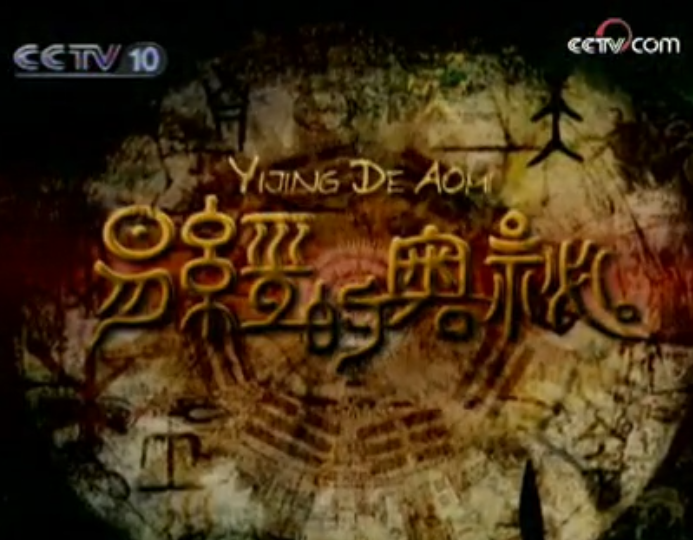
易经的奥秘 (PDF)
* YouTube, 曾仕强讲易经《百家讲坛》

易经的奥秘
* Baidu, 曾仕强, 易经的奥秘, 百家讲坛节目 分集剧情
* 新浪BLOG, 太白童子的博客, 曾仕强主讲:易经的奥秘 全文讲义
* 天涯知识库, 易经的奥秘
*Bilibili, 【东方名家】廖墨香
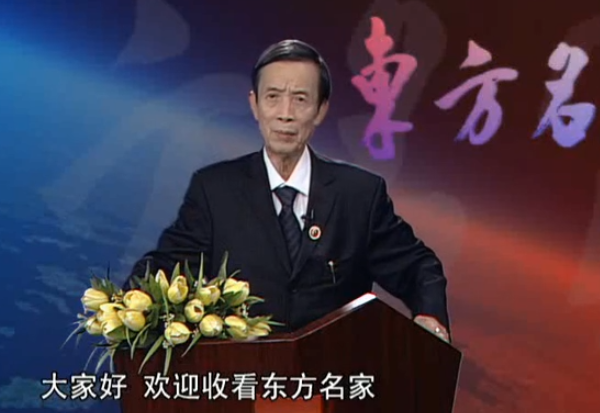
周易预测入门 20P全集
*Bilibili, 【腾讯微讲堂】鲁洪生
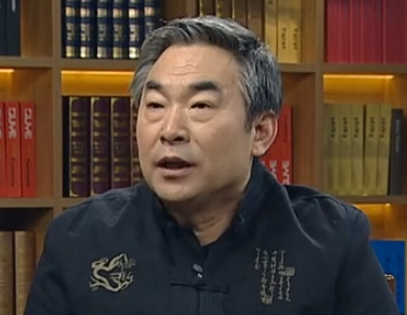
周易 完整版全集
* YouTube, 王思迅
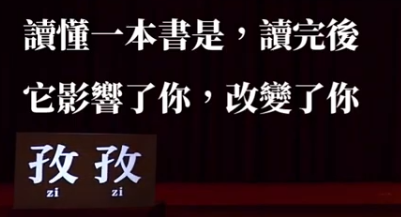
說易經 EP3 - 我們為什麼要讀經典
* YouTube, 鄺侃元

易經的人生智慧講座 2014
* YouTube, 王東岳

第09模塊:《易經》大略與應用概述
* YouTube, 郭明義的雲端講堂, 易經完整版
* YouTube, Pablo Sender, The Wisdom of the "I Ching"
* YouTube, 曾仕强, 易经的奥秘(一),
何为易经 (PDF)
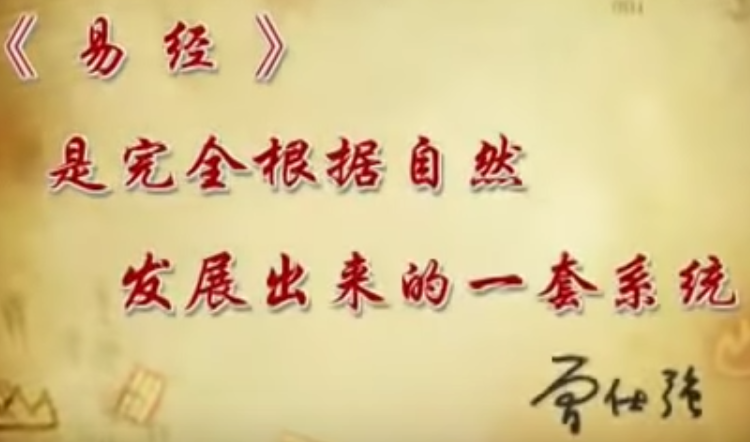
The Book of Changes is a system developed completely based on "natural".
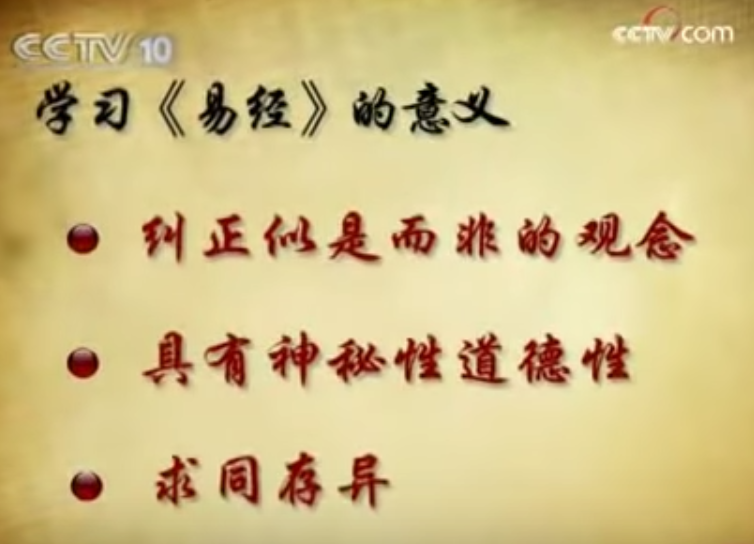
The significance of learning the Book of Changes:
♦ Correct the paradoxical concept of "apparently right but actually wrong".
♦ The Book of Changes has "mystery" and "morality".
♦ Seek common ground, putting differences aside.
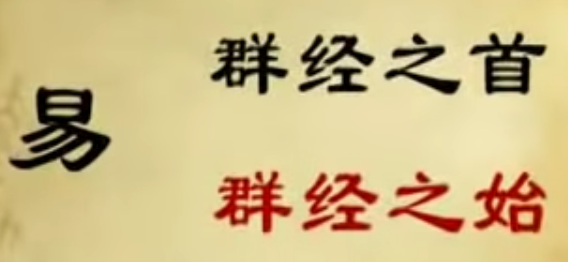
The Book of Changes: Head of the Classics. Beginning of the Classics.
"人更三圣,世历三古"《汉书·艺文志》
更是经过的意思。
人,有三位圣人:
①伏羲画出了《易经》的“先天八卦图”,成为《易经》第一个作者。
②把“周文王跟周公”他们父子一家人,算一个。
——这很合理啊。
周文王根据伏羲的“先天八卦”演绎出了“后天八卦”,
并推演出六十四卦,成为《易经》的第二位作者。
③然后,孔子作《易传》,称作“十翼”,用来解说《易经》的内容,成为《易经》的第三位作者。
伏羲在“上古”;周文王在“中古”;而孔子在“近古”,或者叫做“下古”。
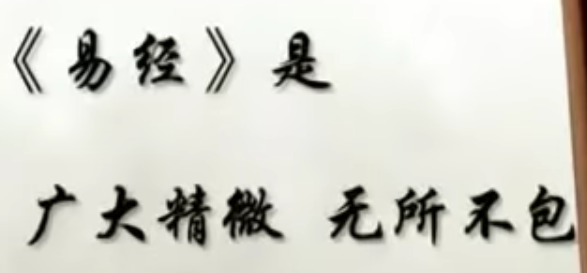
The Book of Changes is vast and subtle, all-inclusive.
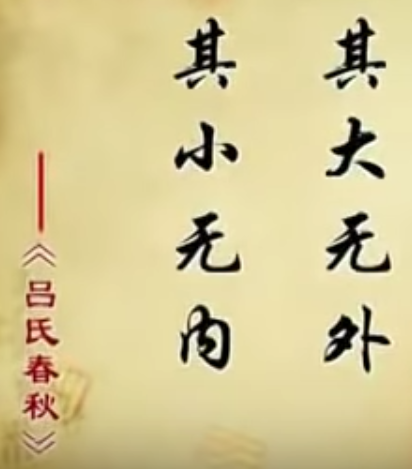
Its big has no outside. Its small has no inside.
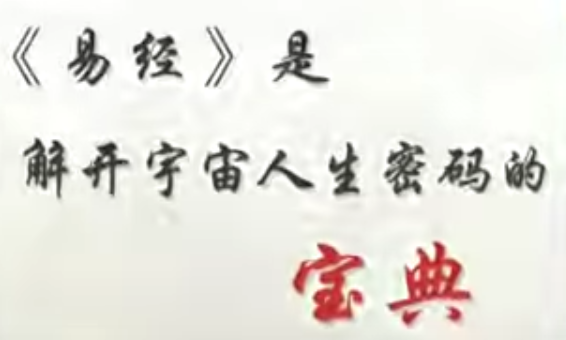
The Book of Changes is a treasure book to unlock the code of life in the universe.
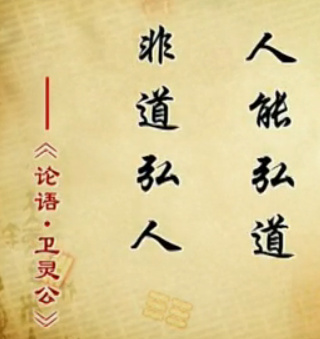
“人能弘道”,是: “人,要去把这个密码好好的来运用”。
“非道弘人!”——你不能在这躺着、等它,说“看它给你一些帮忙。” ——那是不对的!
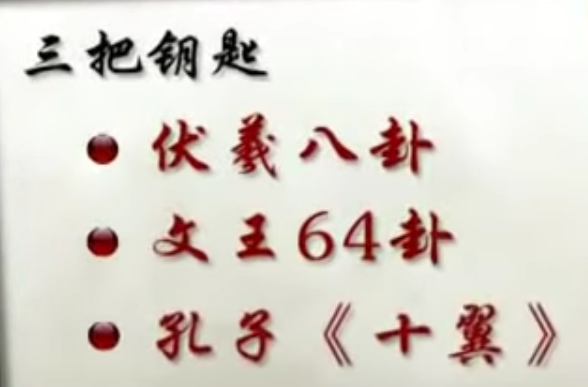
(1) 伏羲的八卦告诉我们一个宇宙最基本的秘密叫做“阴阳”。
Fuxi defines Yin-Yang.
(2) 第二把钥匙,是文王六十四卦。它告诉我们,宇宙只有六十四个密码。
文王六十四卦就是宇宙的六十四个密码,它是用数字来代表的。
(3) 第三把钥匙,是孔子给我们的《十翼》。孔子的理想就是世界大同,而《易经》就是理想的翅膀。
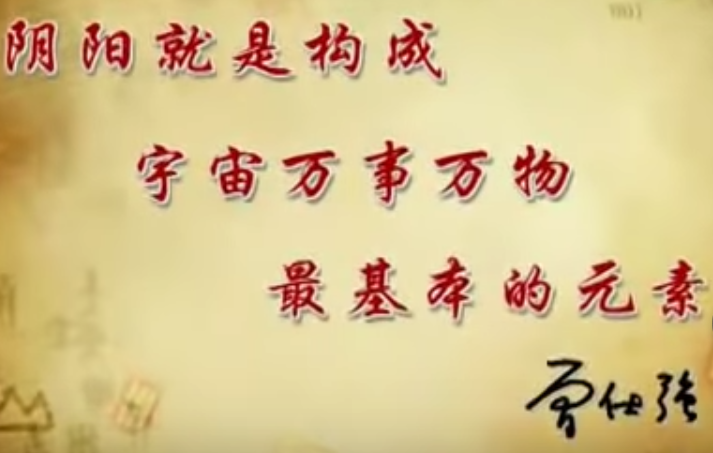
"Yin Yang" is the most basic element that makes up everything in the universe.

* YouTube, 曾仕强, 易经完全通 15
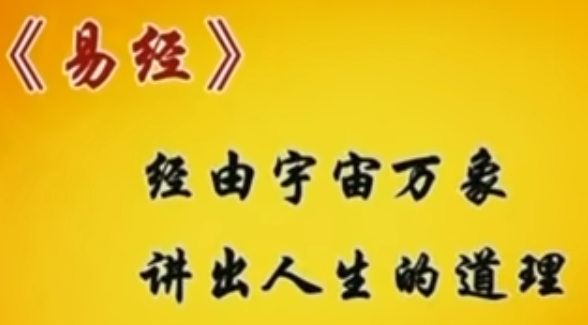
八卦由大自然现象构成
* YouTube, 曾仕强, 易經的智慧 02
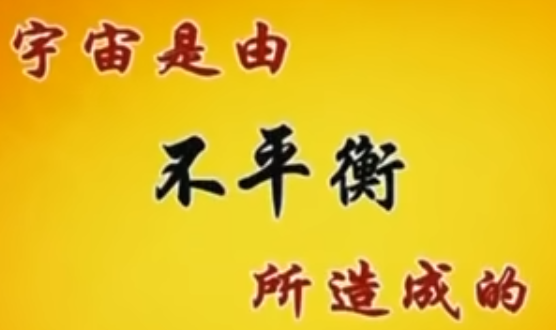
八卦定乾坤
* YouTube, 曾仕强, 易經的智慧 曾仕強 教授主講【上集】全長版 7 52 07
* YouTube, 曾仕强, 易經的智慧 曾仕強 教授主講【下集】全長版 6 28 41
* YouTube, 曾仕强, 易经完全通 06
道德是天人合一的途径:
周文王是把伏羲的天道思想引入了人生的大道.
* Bilibili, 曾仕强, 中华文化的特质(六)
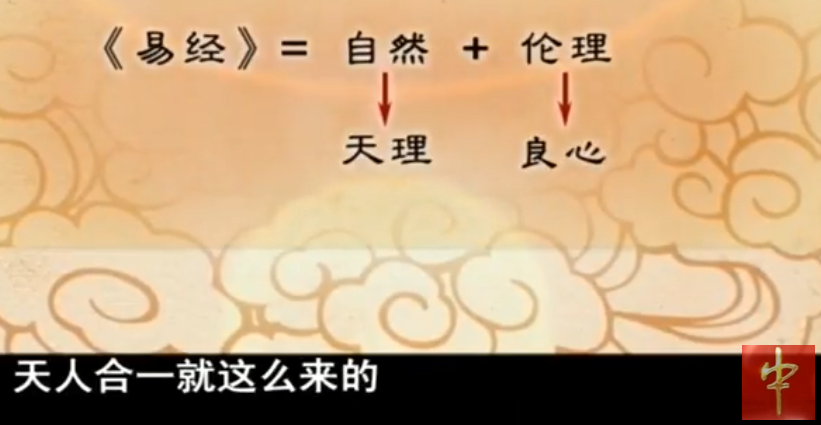
天人合一 (man is integral part of nature) (chinesethought.cn:
heaven and man are united as one)
* 360doc,
《易经》:天人合德,怎样才能天人合一:
古代传说有龙马负图和神龟载书,龙马和神龟身上绘的图案,
被称为河图洛书。不论是龙马负图还是神龟载书,其实它们都是[天垂象 forecasts of heaven]。
圣人观天象后,从中受到[启发 enlighten]而[认知 acknowledge]自然,从而认知自我。
这就是中华传统文化独特的天人合一,中华民族不会崇拜神袛,而[敬畏 in awe / en admiration]上天。
孔子说天垂象一般人看不懂,只有圣人才会看懂。一般人看到天垂象[无动于衷 indifferent],
但是圣人会观察[体会 understand]其中的道理。
孔子讲的圣人就是伏羲和周文王,伏羲[仰观天象 looking up at the sky ]、俯察地理,画出了八卦。
八卦以天象为出发点,所以被称为天人之学,表示天人是合一的。
周文王演绎八卦,文王最大的贡献是把伏羲的天道引入人道。
把八卦两两相重变成六十四卦,每一个卦取一个卦辞,每个爻也有爻辞。
孔子觉得把天道变成人道是不够的,需要把易经的道理转换成人生的[行事规则 rules of conduct]。
孔子的用意是告诉人们天人怎么合一,人生的最大目标就是[修德 cultivate one's morals],
只要修得合乎天道,才能天人合一。
孔子说人和动物最大的不同就是[伦理 ethics][道德 moral]。人生最重要的就是[修身修己 self-cultivation],
孔子站在人道的立场发扬易学,人应该终身致力于天人合德。
* YouTube, 星滙網 Star Internet Radio Hong Kong
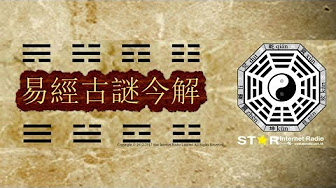
易經古謎今解
* YouTube, 余中哲, Taoist TV
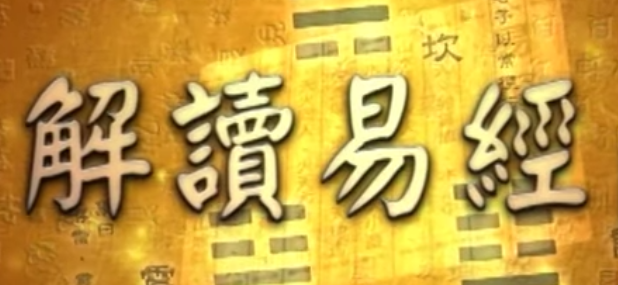
解讀易經I
* YouTube, 余中哲, Taoist TV

解讀易經II
* YouTube, 曾仕强
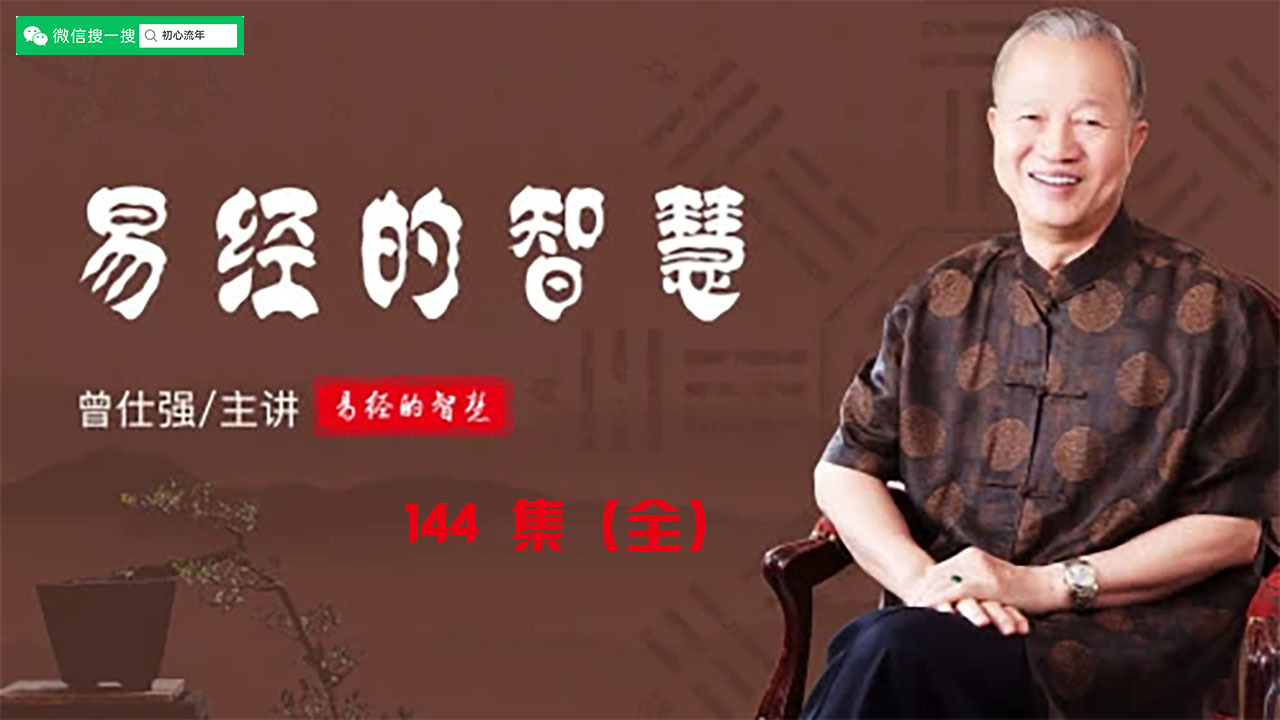
解易经六十四卦
* YouTube, 曾仕强

易经的智慧144集全集-上经
* YouTube, 曾仕强

易经的智慧144集全集-下经
* YouTube, 曾仕强
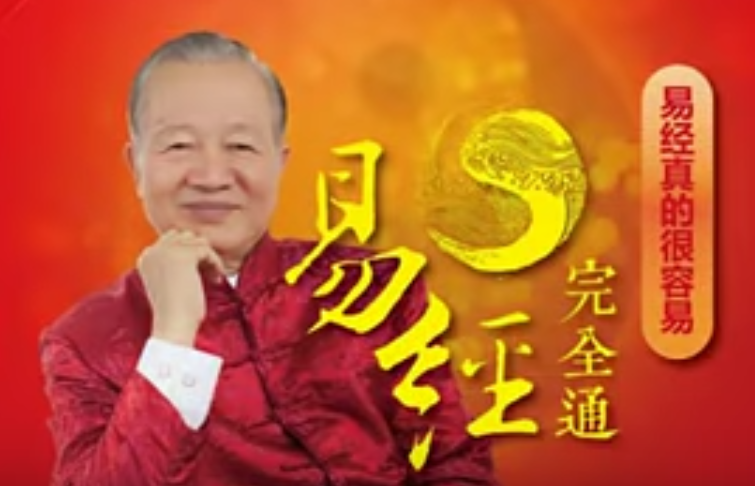
《易经完全通》24集
* 哔哩哔哩, 曾仕强

《易经完全通》24集
* 哔哩哔哩, 曾仕强

易经完全通 第一部分 易经基础 13集全(基础班)
* YouTube

易經的智慧(中文系)
* YouTube, Herman Yeung, 周易 (易經) Mathematics 第1節 - 由來
* YouTube, 傅佩榮, 易經通講
* YouTube, 傅佩榮, 易經入門十七講
* YouTube, 刘君祖
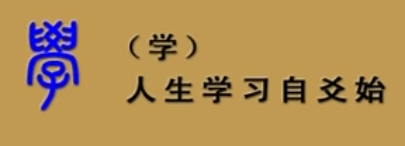
易经智慧与个人修行
2. Book of Changes 易經
* Lokmane Benaicha,
Histoire du《Yi Jing》: les trois Yi
Le《Yi Jing》est une transcription symbolique et mathématique des lois du Ciel,
une miniaturisation du cosmos pour mieux le comprendre mais aussi comprendre
la nature et les humains.
* 中國哲學書電子化計劃 Chinese Text Project, 易經, James Legge translation (King Wen order)
* 易學網, 易經[周易]原文 (Opposition presentation)
* 易安居吉祥网, 六十四卦 (Ying Yang presentation)
* 国学梦,
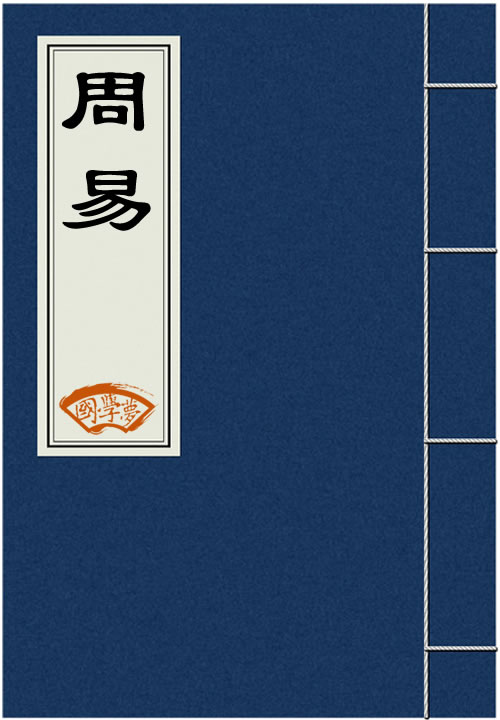 周易 (King Wen order)
周易 (King Wen order)
* 太极书馆, 周易
* 高雄市立空中大學, 胡以祥, 易經導論 第01-36講 (2019版) (PDF file)
* 溫 故 Wengu,

Yi King, le Livre des Mutations, traduction de Richard Wilhelm (Ying Yang presentation)
* L'école Saolim, Yi-King, le livre des changements (King Wen order)
* Chinasage, Yi Jing 易经 (I Ching WG) - The Book of Changes (King Wen order)
* Yijing, the Hexagrams, Index (Family presentation)
* Carl Gustav Jung et le Yi-King (King Wen order)
* Panther Webworks, I Ching, Book of Changes, Richard Wilhelm’s and Cary F. Baynes’ translations (Family presentation)
* Sacred-texts, I Ching, The Book of Changes, translated by James Legge (King Wen order)
* Baharna, I Ching, The Book of Changes, translated by James Legge (King Wen order)
* Michael Servetus, The Gnostic Book of Changes (King Wen order)
* Tuck Chang
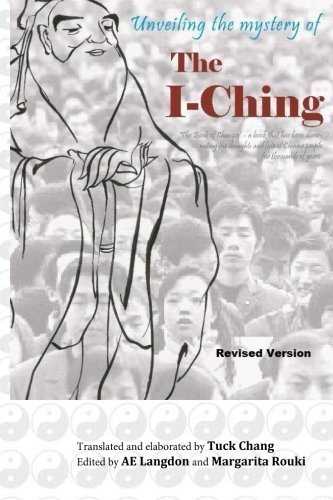
Unveiling the mystery of the I-Ching (Family presentation)
* Yi King, traduit par Paul-Louis-Félix Philastre (1837-1902), ( PDF)
* Yi King, le Livre des Transformations, version allemande de Richard WILHELM, traduite par Etienne Perrot, ( PDF)
* I Ching, translated by Richard Wilhelm (Family presentation)
*
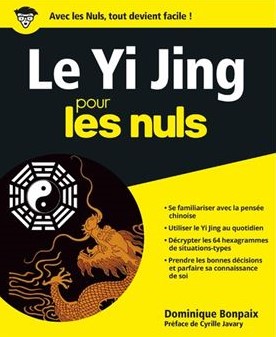
Le Yi Jing pour les nuls, Dominique Bonpaix (epub file)
*
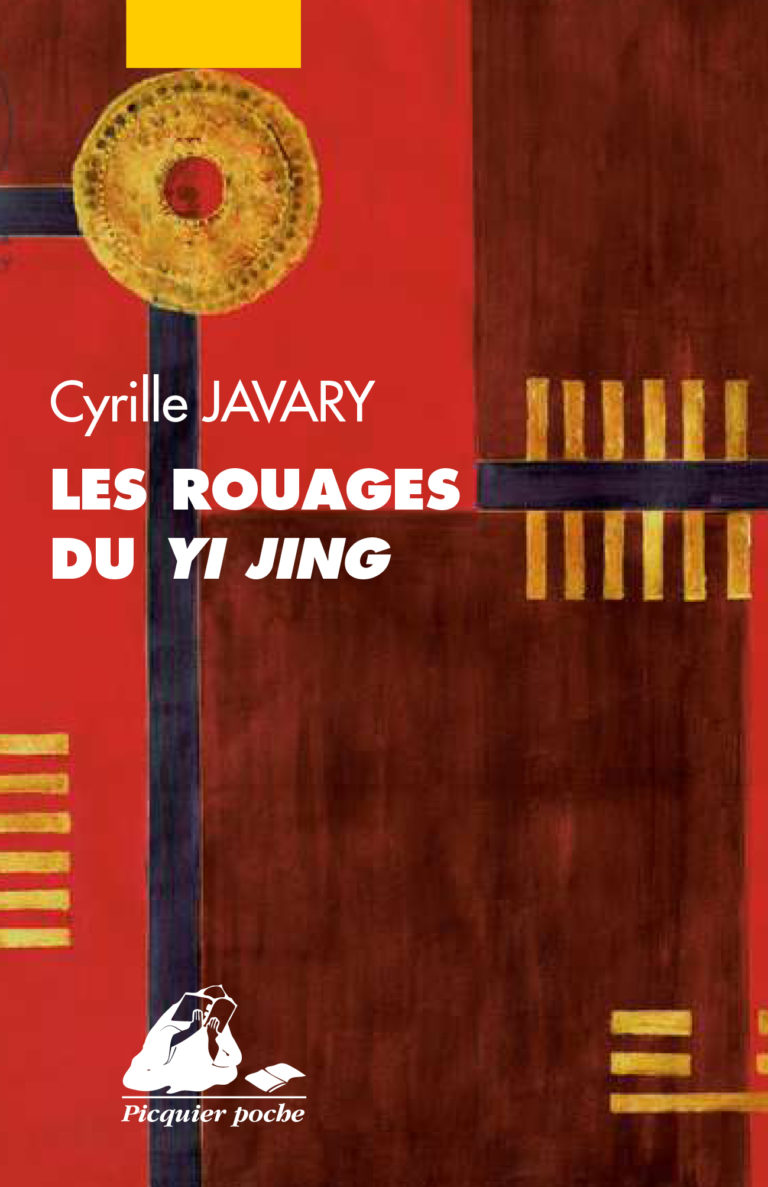
Les
Rouages du Yi Jing, Cyrille Javary
一陰一陽之謂道.
Une fois Yin une fois Yang cela est appelé Tao.
*
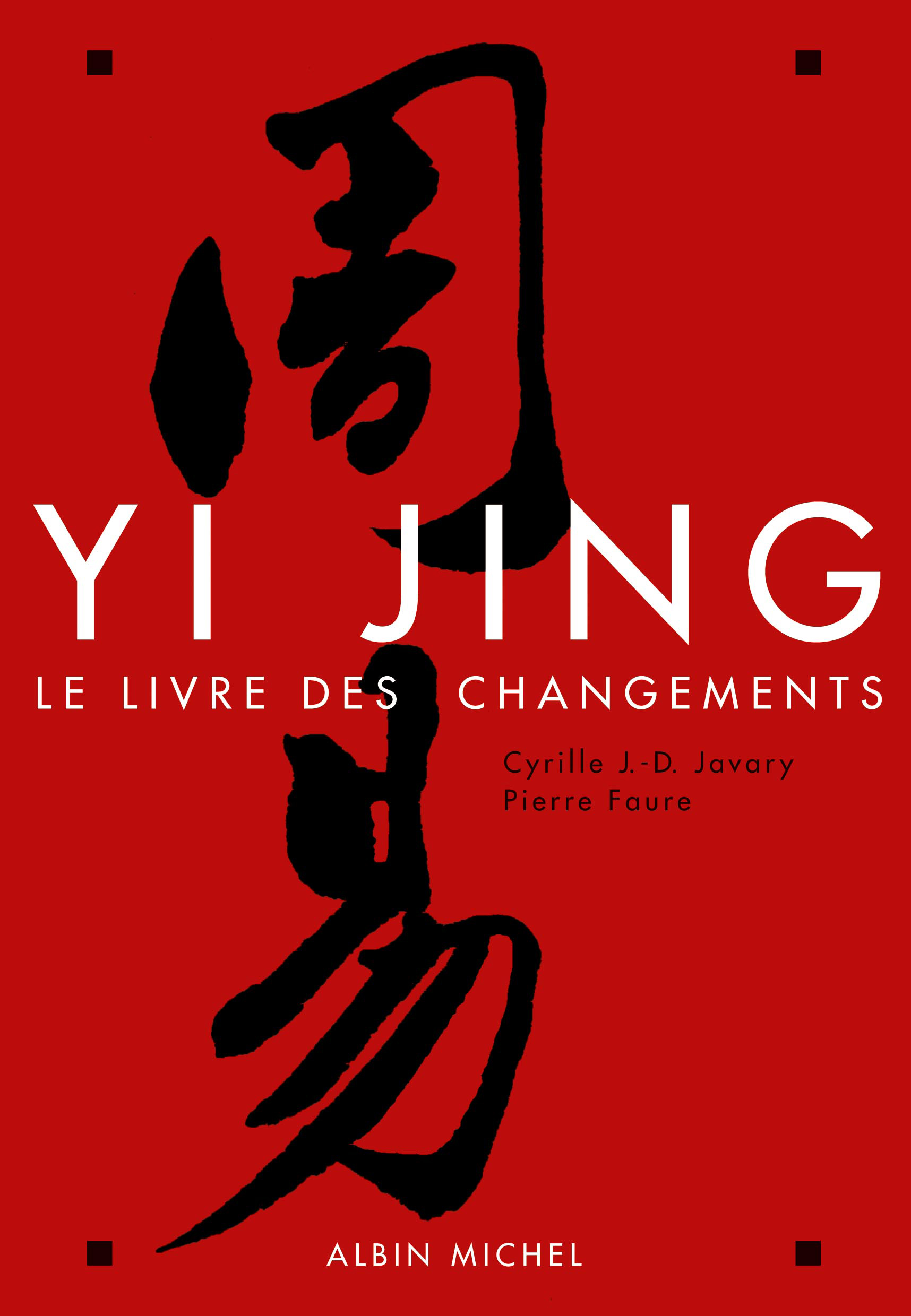
Yi Jing, le Livre des Changements, Cyrille J.-D. Javary et Pierre Faure ;
DJOHI,
Yi-Jing, un manuel d'aide à la prise de décision
*
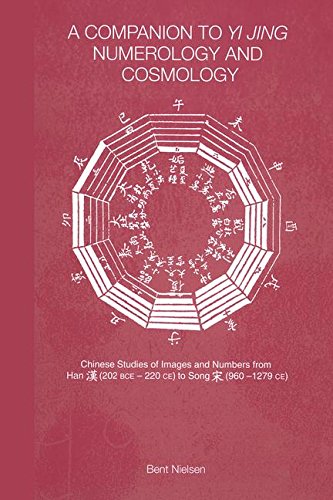
A Companion to Yi Jing Numerology and Cosmology, Bent Nielsen (Routledge Curzon, New York, 2003)
*
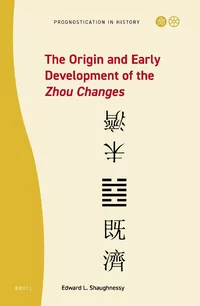
The Origin and Early Development of the Zhou Changes, Edward Shaughnessy
(Brill, Leiden, 2022)
Open access
*
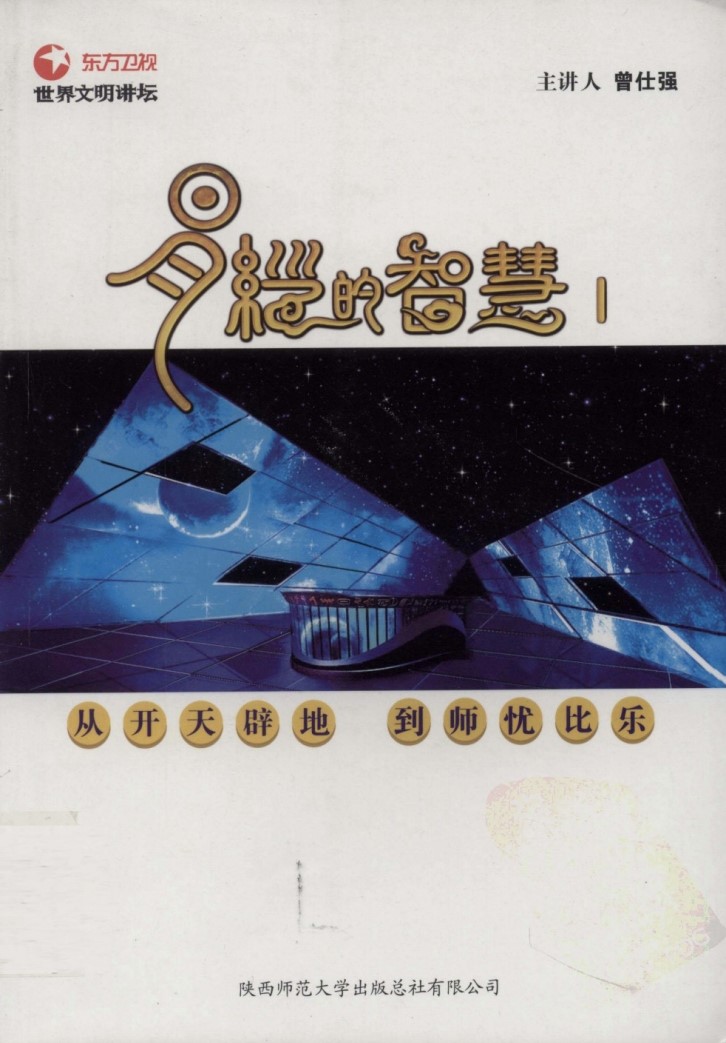
《易经的智慧(1-6)》由曾仕强著
( 陕西师范大学出版总社有限公司, 2010)
3. Zhou Yi 周易 (易經)
周易预测宇宙万物变易规律的典籍。
Zhou Yi is the classics predicting the law of change in the universe.
* 163.com,
曾仕强教授谈“易经” | 读易经最要紧的,是明白这2句话……
《易经》推天道以明人事,讲究阴阳互应,刚柔相济,[提倡 promote][自强不息
one should strive continuously to strengthen himself]、[厚德载物
a person of great virtue can shoulder great responsibilities],
是解开宇宙人生密码的宝典。
《易经》的道理是[超越 beyond]宗教的。易理从哪里来?从自然来,叫做道法自然。
* Hon Tze-Ki,
Chinese Philosophy of Change (Yijing),
Stanford Encyclopedia of Philosophy (Summer 2019 Edition), Edward N. Zalta (ed.)
* David Yek,
The brief anatomy of Yijing
Taking a script out of “The Great Commentary” DaZhuan 大傳, it says:
“Thus the closing of the swinging gate is called kun 坤;
the opening of it is called qian 乾.
The ongoing alternation of openings and closings is called flux (bian 變),
and the inexhaustibility of the comings and goings is called continuity (tong 通).
When something is manifest, it is called an image (xiang 象),
and taking on physical form it is called a phenomenon (qi 器).
To fashion and make use of these things is called emulation (fa 法).
Putting them to good use in everything that is done so that all of the people
can take advantage of them is called spirituality (shen 神).”
* Joseph A. Adler 艾周思,
"The Great Virtue of Heaven and Earth 天地之大德:" Deep Ecology in the Yijing 易經
(PDF)
* 勸學網(劝学网),
易经、易经学习、周易预测系列
(1)
易经入门学习教程
(2)
周易
* 每日頭條,
「易經概論」群經之首,大道之源:
簡易:把複雜的問題簡單化。
變易:以「變」的[主導思想 leading thought],看待一切事物。
不易:「一陰一陽之謂道」的主導思想,是[永恆不變的 eternal]。
後天六十四卦即文王六十四卦反映了事物變化的具體規律,從中我們可以看出陰陽互補、物極必反等規律。
* 每日頭條, 曾仕強,
學習《易經》很容易嗎?老實講《易經》真的很容易:
自然界的變化,並非由於外在的動因所造成,而是一陰、一陽的互動、交感,產生的結果。
我們是自己的主宰,必須為自己的所作所為,負起全部的責任。
易經的「易」字,一方面有「變易」的意思,而另一方面,也有「不易」的需求。
凡是盲目求新,一味地求變,便是只看到「變易」,卻嚴重地[忽略 neglect]了「不易」。
不易是[常則 = 一定的规则],這種變中之常,是超越時空,無所謂新舊。易經的「經」字,
便是不變的道理,必須經常當做遵守的法則。
* Zhihu 知乎, 如何读懂《周易》?
* Zhihu 知乎, 怎样自学易经?
* 360doc, “周易”二字释义
* YouTube, 易经的奥秘 (一) 何为易经
(PDF):
周是很周密,很周详,而且它是周流不停、往复循环、生生不息的,所以才叫《周易》
* 西瓜视频, “周易”就是指周朝的“易经”?汉字的博大精深,超乎你的想象!
* YouTube,
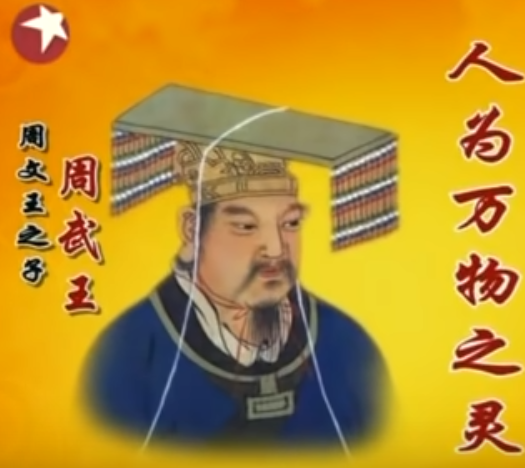
易經的智慧 03.易經與命運
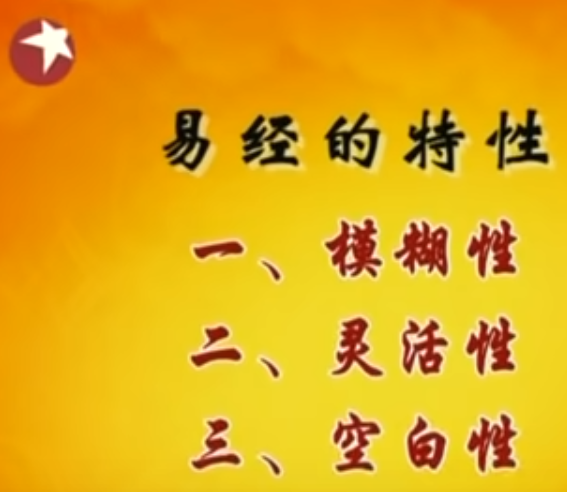
*

《易经》的四大法门:象数义理
六十四卦最初没有文字说明。孔子注《易传》,从象数角度解释卦爻辞,[赋予其 give it]哲理。
在孔子之后,易学发展出“象数”、“义理”两大学派。根据研究思路的不同,
《易经》研究者分为四大派:象、数、义、理;而象与数、义与理又可分别归为一类。
有人认为,象数派接近自然科学,义理派接近社会科学。象数讲的是事实的“必然”性,
义理则着重讲为何会“必然”。象数是《易经》的基础,《易传》的义理由象数变化而出。
* 台灣學佛網, 《易經》大道:天道剛健、地道厚實、人道中庸
* ChinaKnowledge, Yijing 易經 or Zhouyi 周易
* YouTube, 张其成, 《文明之旅》 20160711 《周易》的智慧 | CCTV-4:

卦象(伏羲)、 卦辞(文王)、爻辞(周公)、易传(孔子)

我认为《周易》更重要是用来什么昵 改命
In my opinion, the "Changes of Zhou" is more important for changing the fate.

人的命怎么改呢
How to change the fate?
要按照天命来改
We should change the fate following the mandate of Heaven.
要符合天道
It should conform to the natural law.
那天道就是宇宙变化的大规律里面
Among the general laws of changes in the universe,
其中有一条规律 叫因果律
there is one law called the law of Causation.
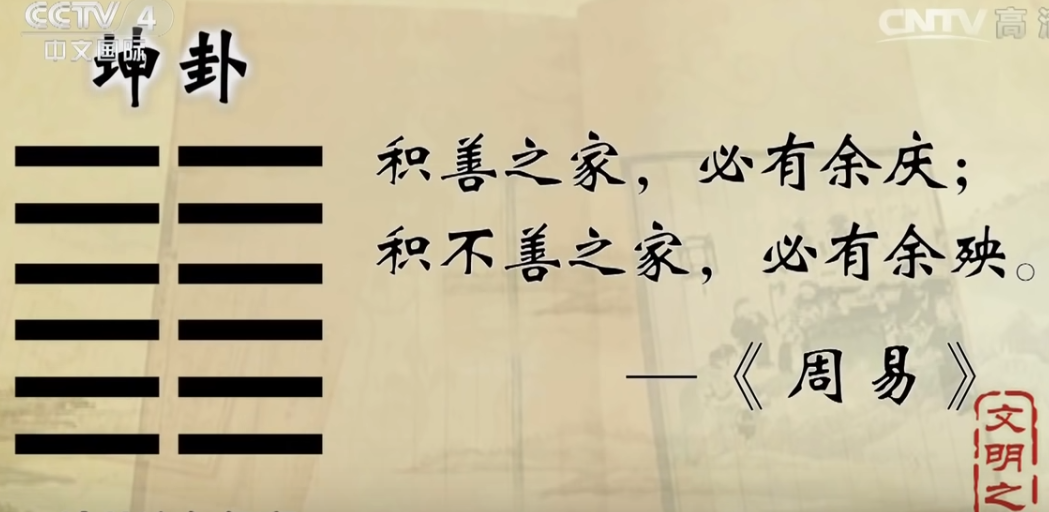
坤卦这句解释
Kun Hexagram explains
积善之家 必有余庆;
"A family given to kindness and charity must be rewarded.
积不善之家 必有余殃。
while a family which is not given to kindness and charity must be punished."
就是因果。
It means Causation.
做善事的人必有善报
Goodness will have a good reward.
做恶事的人必有恶报
Evil will be rewarded with evil.
这就是天道规律。
This is the natural law.
这叫公平性原则。
So it is called principle of equity.
因为《周易》它讲的揭示的是
Because the "Changes of Zhou" reveals
一个宇宙周期变化的大规律
the general law of periodic changes in the universe.
你如果把这个规律搞懂了
If you understand this law well,
你当然可以预测
you can surely forecast.
所以我们《周易》同样也是如此
It is also how the "Changes of Zhou" helps us.
它告䜣我们这个规律之后
It tells us the law
我们要遵循这个天道规律来做
and we do things following the law.
你就可以趋吉避凶 趋利避害
In this case you can pursue good fortune and avoid disaster or draw on advantages
and avoid disadvantages.
这就是改命
This is changing the fate.

如果说《易经》中的象和数,是变化的现象,那么《易经》中的理就是不变的规律。
我们学习《易经》,就是要透过变化的现象,掌握那个不变的规律。
* 傅佩荣教授
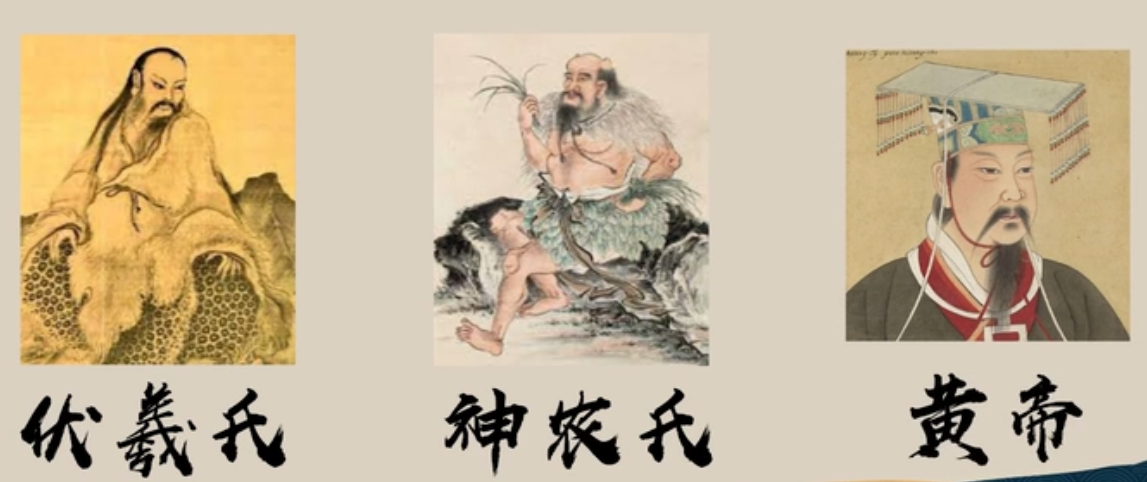
黃帝的时候才造字。仓颉造字。所以以前的《易经》只有64个图。
* Zhihu, 有孚君, (思维导图)《周易》和《易经》傻傻分不清?再一篇干货为你拨开迷雾……
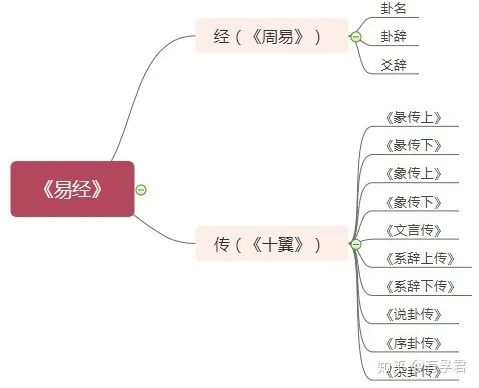
Zhou Yi is the original core of the I-Ching or Yi Jing. Zhou Yi consists of 450 lines.
傳是用來解釋經,不是去改變經的。我們現在一般對《易經》的了解及概念,其實是從《易傳》來的。 《易傳》把《易經》從一本卜筮用書,提昇至哲學層次的經典。
* 微博, 易经入门教程:怎样学习易经,周易学习方法

Ten Wings 十翼:
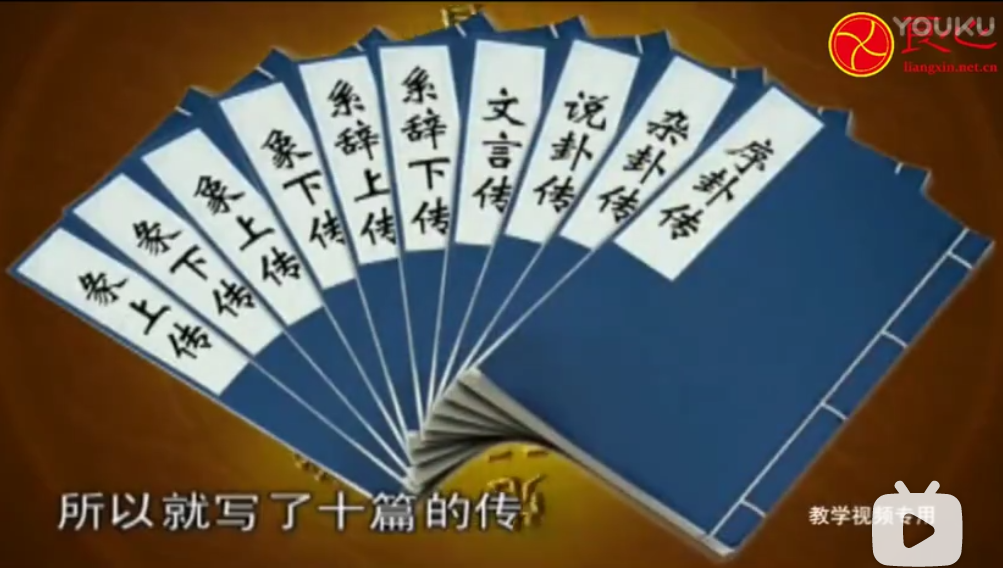
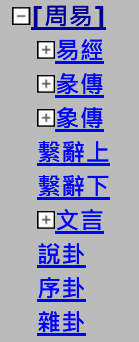
- Tuan 彖傳 Judgment I 彖是断的意思,每卦都有"彖曰", 又称"彖辞",论断卦象,卦德和六爻的排列
- Tuan 彖傳 Judgment II
- Xiang 象傳 Image I 象表示"像"的意思,卦象为大象,爻象为小象,用来模拟形态和事理
- Xiang 象傳 Image II
- Xici 繫辭傳 Great treatise I 系是"联络","联系" 的意思,上篇以形而上的道体为主
- Xici 繫辭傳 Great treatise II 下篇以形而下的𠾖用为主
- Wenyang 文言傳 Words of text 乾卦和坤卦,各加文言传,仔细加以解说
- Shuogua 說卦傳 Discussions of trigrams 说明八卦所代表的意义,以及八卦相重的由来
- Xugua 序卦傳 Sequence of hexagrams 说明六十四卦的次序
- Zagua 雜卦傳 Miscellaneous notes on hexagrams 解释六十四卦的卦名
* Jim Cleaver: 十翼 Shí Yì, THE TEN WINGS, An Over view (PDF)
* yijing.website: 十翼, the Ten Wings (Wings five, six, seven, eight and ten)
* zhwmzh.com:
《易传》的内容有哪些,《易传》和《易经》的关系
《易传》是一部解释《易经》的作品。《易经》本是卜筮之书,只是对一些占卜结果所作的记录,
反映了古人对无法把握的外在世界的一种理解或认识。由于《周易》经文深奥简古,
春秋时期的学者阅读此书,就已经感到十分困难,于是,解释经文的文字开始出现,
历史上称为《易传》,又称《周易大传》。在古代,“传”有解说之义,凡解说、阐发经典著作意义的文书,皆可称为“传”。
* zhwmzh.com:
易经杂说
第三不易,万事万物随时随地都在变的,可是却有一项永远不变的东西存在,
就是能变出来万象的那个东西是不变的,那是永恒存在的。
那个东西是什么呢?宗教家叫它是“上帝”、是“神”、是“主宰”、是“佛”、是“菩萨”。
哲学家叫它是“本体”,科学家叫它是“功能”。管它是什么名称,反正有这样一个东西,
这个东西是不变的,这个能变万有、万物、万事的“它”是不变的。
* zhwmzh.com:
周易的哲学思想之一:天人合一
《周易》这部书,讲的是理、象、数、占。[从形式和方法上 in terms of form and method ],
[好象专论 it seems to be exclusively on]阴阳八卦。但实际上,它[论述 dissertation]的核心问题,
是运用“一分为二”对立与统一的[宇宙观 cosmology],
[唯物主义和辩证法的方法论 methodology of materialism and dialectics],
[揭示 reveal]宇宙间事物发展、变化的自然规律,
对立与统一的法则,[并运用这一世界观 and use this worldview],
运用八卦预测自然界、社会和人本身的各种[信息 information]。
《周易》中,每卦的六爻可分为三组,每组两爻。最上的一组(上爻、五爻)代表天道,
最下的一组(初爻、二爻)代表地道,中间的一组(三爻、四爻)代表人道。
《说卦》说:“立天之道,曰阴与阳。立地之道,曰柔与刚。立人之道,曰仁与义”。
这里天道、地道指的是自然法则,人道指的是[社会伦理 social ethics]法则。
把自然界、人类社会和伦理法则看成是一个有机联系的整体, 是《周易》天人合一观的哲学[特征 feature]。
* 大纪元 epochtimes.com:
金剑:“一分为二”之局限及滥用的危害
老師告訴我們「看問題不要走極端,事物都是有兩面性的,要一分為二地看問題……任何事物都是一分為二的;
任何事物既有好的一面,也有壞的一面;任何事物既有對之處也有錯的地方。」
錯就錯在這裡,「任何…都是…」這句話本身就是走極端,因為世界非常複雜,
事物有一分為二,也有一分為三、一分為一、一分為零、一分為十、一分為無窮多…等等各種情況,
一分為二只是其中的一種情況,用它來概括所有的事物就會出現巨大的漏洞,甚至是指鹿為馬。
* 劝学网
卦辞的[结构 structure]
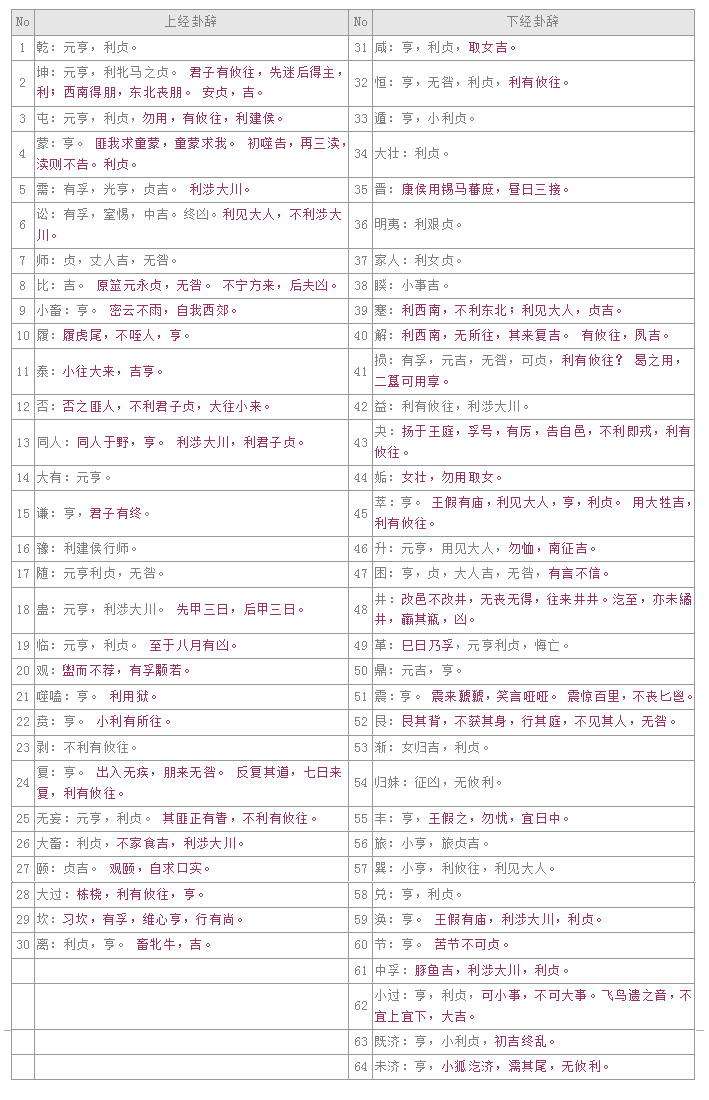
卦辞有三样内容:①卦名、②判断词、③警告语。并不是所有的卦辞都包含警告语,
判断词是用来说明卦的吉凶好坏,警告语是对判断词的补充说明,这也是卦辞中最难理解的部分。
* 百度 baike.baidu.com:
彖传
彖传分上、下两部分,为《易传》中的两篇。说明《易经》各卦之义,
专门解释卦名、卦象、卦辞。[而不涉及 without involving]爻辞。
* 大紀元 epochtimes.com:
六十四卦雜記(三) — 甚麼是「彖」
甚麼是「彖」﹖「彖」是斷的意思,也是下定論的意思。簡單一些來講,
「彖」就是用幾個字或是一連串的字去判定,去敲定一個卦(指六爻卦)的特性和意義,
「彖」這個字在「周易」中有二種不同的解釋,因此常常會使初學者感到困擾。
* 知乎 zhuanlan.zhihu.com:
怎么用《周易·大象》来理解《易经》
《周易》分为《易经》和《易传》。其中《易传》由十篇文章组成,也叫做《十翼》。
其中《象》是专门解释六十四卦的卦象、卦名、爻象、爻辞的,唯独不涉及卦辞。
其中专门解释卦象和卦名的,叫做《大象》;专门解释爻象、爻辞的,叫做《小象》。
《周易·大象传》针对六十四个卦象和卦名,做了六十个解释,一共是六十四句话。
这六十四句话的格式完全一致:卦象+卦名+人事。
《大象传》中出现了六十四条君子告诫,可以说《大象》是一本君子教科书。
《大象》的句式结构都是“君子应该干什么”而不是说做了什么是君子。
* 國立政治大學北加州校友會, 李仁龍,
易經淺釋 (PDF):
東漢鄭玄《易論》認為「易一名而含三義:易簡一也;變易二也;不易三也。」
《繫辭傳》論《易經》的基本原理
A. 一陰一陽之謂道
(1) 以陰陽說概括易經基本原理,始於此。
(2)《易》將事物的性質及變化法則概括為一陰一陽。
(3) 任何事物均存在著對立的兩重性。
B. 剛柔相推而生變化。
(1) 重視變通。
(2) 相推過程中,其對立面的相互作用,既有相交也有相攻。
(3) 爻象和事物的變化,是有規律的。
C. 易與天地準
(1) 易理源於自然,效法自然,是天地的模寫,易與天地的法則是一致的。
(2) 易包容了世界的一切法則。
* Zhihu, 张成老师,
易经入门必备知识
易经的核心就是著名的“三易说”,即:简易、变易、不易。
1、简易:是指世界上的事物再复杂再深奥,一旦人类的智慧达到,
就可以把它们转换成人们容易理解和处理的问题。
2、变易:是指世界上的万事万物每时每刻都在变化发展着,没有一样东西是不变的,
如果离开这种变化,宇宙万物就难以形成。
3、不易:是指在宇宙间万物皆变的前提下,还有唯一不变的东西存在,
就是能变出万象之物的东西不变;即是说万物皆变的规律是永远不变的。
所谓"不易",就是基本平衡;"变易"就是发展变化,就是不平衡;
"简易"就是世界上所有最复杂的事物可以用最简单的符号来概括。
发展变化、不平衡是绝对的、永恒的,平衡是相对的、暂时的。
* Zhihu, 漫画《易经》,一看就懂,一学就会
* Zhihu,
用《易经》透过现象看本质:
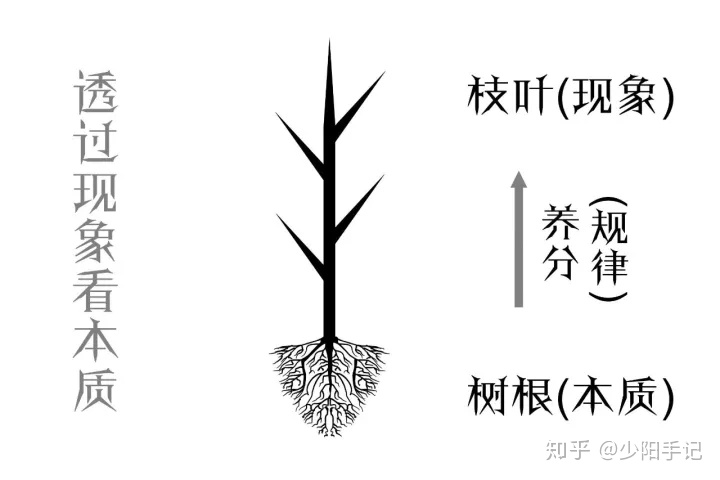
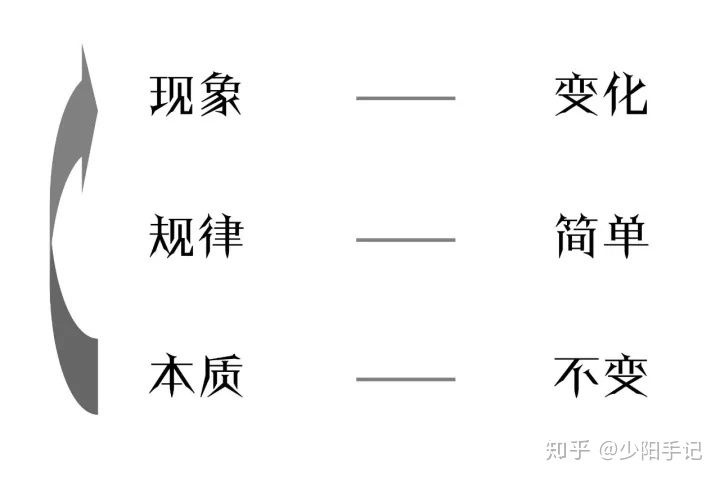
“易有三义”,就是说《易经》当中的“易”字,有三种内涵,或者说有三种意义。
变易,是变化的现象,为“相”。
不易,是不变的本质,为“体”。
简易,是简单的规律,为“用”。
* Zhihu, 周易是本什么书
* YouTube, 育龙讲堂

00易经产生的历史渊源《易·王》易龙、龙吟经典讲解
* 哔哩哔哩, 《周易术数学》讲解
* Yijing Dao, 1935 Harvard-Yenching Zhouyi
* zh.wikisource, 周易 (Ying Yang presentation)
* 周易入门, 《易经》六十四卦卦爻辞详解-纳甲分宫 (Mutation sequence or Eight Palaces sequence)
* biroco.com, Harmen Mesker, The Eight Houses (PDF)
* 360.doc
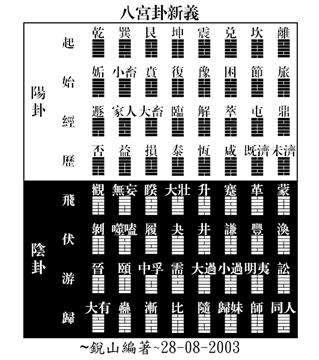
六十四卦序列特点—京房八宫
* Baidu,
周易 (易经)
《周易》六十四卦的排列,有着内在的根据,按照古人说法,这种排列反映了世界产生、发展、变化的过程,
以乾坤为首,象征着世界万物开始于天地阴阳,乾为阳,为天;坤为阴,为地。乾坤之后为屯、蒙,屯、蒙,
象征着事物刚刚开始,处于蒙味时期。……上经终于坎、离,坎为月,离为日,有光明之义,
象征万物万事活生生地呈现出来。
下经以咸恒为始,象征天地生成万物之后,出现人、家庭、社会,咸为交感之义。
指男女交感,进行婚配。恒,恒久,指夫妇白头到老。社会形成以后,充满矛盾,
一直到最后为既济、未济。既济,指成功,完成。未济表示事物发展无穷无尽,没有终止。
《周易》作者力图使《周易》六十四卦排列符合世界进化过程。
但是这种排列并不是[唯一 unique]的。
1973年在湖南长沙市东郊的马王堆汉墓中发现了写在帛上的《易经》叫帛书《易经》,
帛书《易经》排列完全不同于今本《周易》,它是按照八卦相重的原则,把《周易》六十四卦分成八组,
叫八宫,六十四卦分属于八宫。
唐人孔颖达曾用“二二相偶,非覆即变”来概括六十四卦卦画排列的特点。
所谓“二二相偶”,是指《周易》六十四卦两两为对,共三十二对,如乾坤为一对,屯蒙为一对,
按顺序依次为对。所谓“非覆即变”,是指《周易》三十二对每一对的卦画不是颠倒,就是相反。
覆,颠倒;变,相反,如(屯)倒置为(蒙),(需)倒置为(讼),这是覆。(乾)与(坤)相反,
乾六爻全为阳爻,坤六爻全为阴爻,(颐)与(大过)相反,颐上下为阳爻中间四爻为阴爻,
大过上下为阴爻,而中间四爻为阳爻,二者卦画完全相反,这就是变。
《周易》六十四卦三十二对,有二十八对为“覆”,有四对为“变”,
即除了乾坤、颐大过、坎离、中孚小过变卦外,其它与对皆为覆卦。
* 宅學習, 帛書 vs 通行本卦名卦序
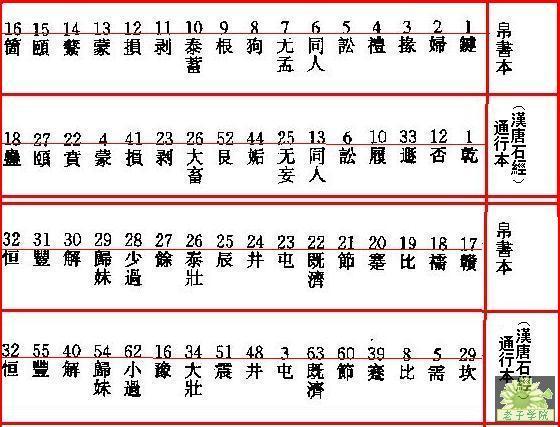
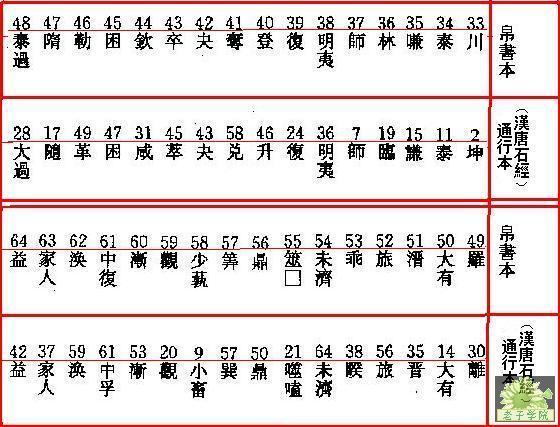
馬王堆帛書易經卦序
* Tencent
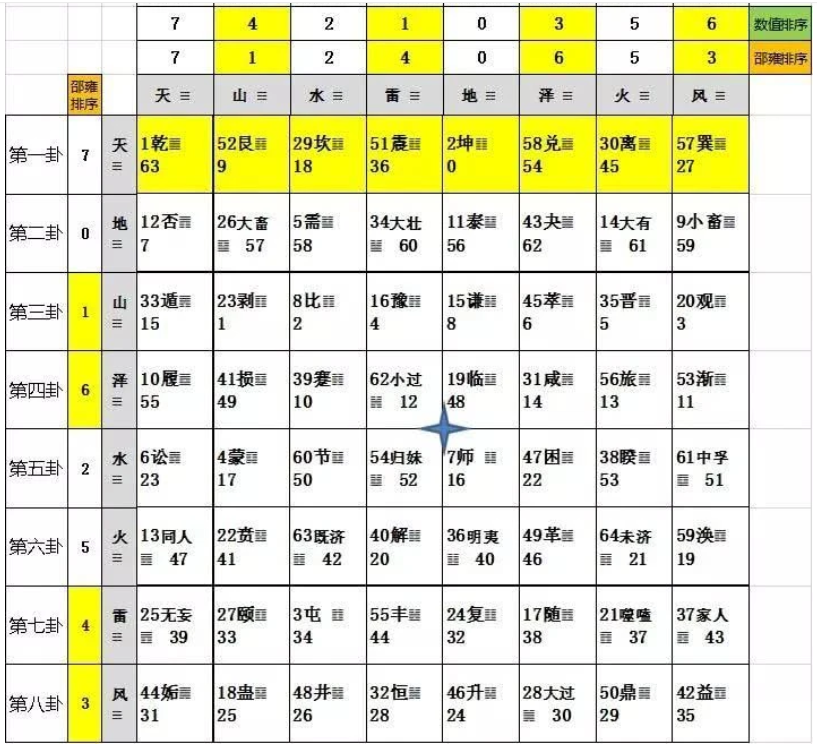
马王堆帛书周易究竟是怎样排序的?
* 娱乐新闻网, 帛書 vs 通行本卦名卦序
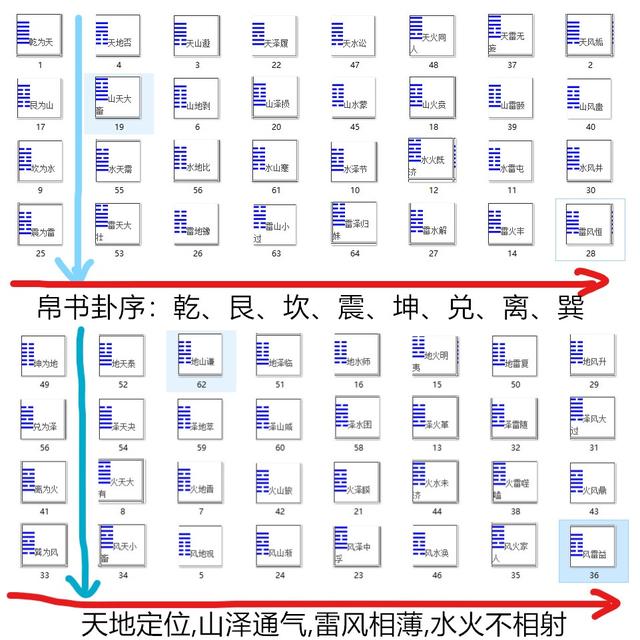
杂谈周易—关于饶宗颐先生对马王堆《易经》卦序作浅谈
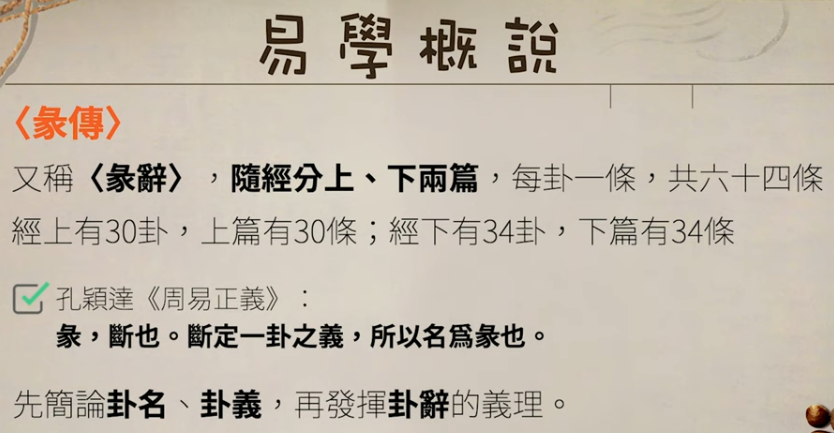
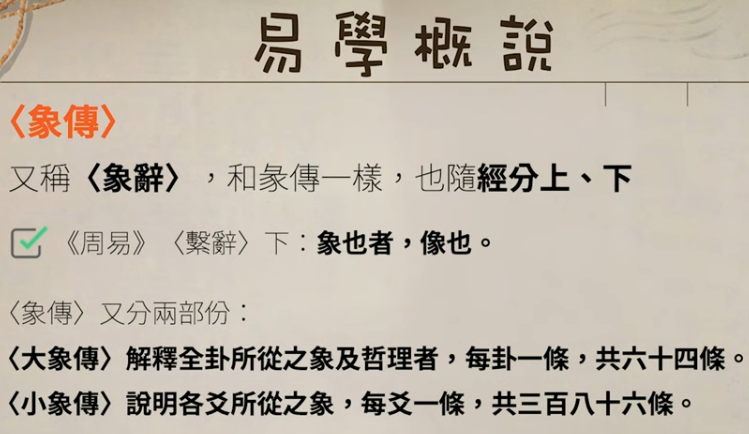
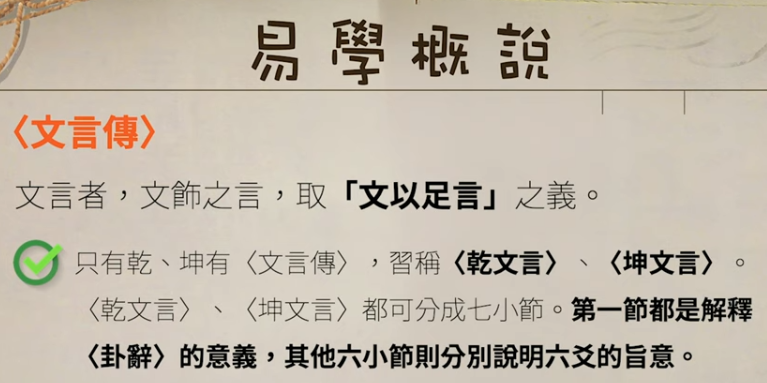
* 360doc, 周易象传:周易大象传、小象传全文
* Baidu, 象传
* Baidu, 大象传
* 易學網, 大象傳的解讀
* 大家找算命网, 周易六十四卦爻辞详解 (Circular Xiantian diagram)
* Baidu,
用九
阳爻为什么叫九?阴爻为什么叫六?
六为老阴、七为少阳、八为少阴、九为老阳。老变少不变。
4. Hexagram sequence 卦序
* 每日頭條,
《周易》為何上經三十卦,下經三十四卦,而不是各三十二卦呢?:
六十四卦構成了一個和諧的整體:上經始於乾坤,終於坎離。「乾、坤者,陰陽之本始,
萬物之祖宗,故為上篇之始也。離為日,坎為月,日月之道,陰陽之經,所以始終萬物,
故以《坎》《離》為上篇之終也。」
下經三十四卦從咸恆開始,咸為交感,喻指男女婚配交感;恆為恆久,喻男女白頭到老。
「有天地然後有萬物,有萬物然後有男女」(《序卦傳》),從人到家庭、社會漸次展開,
充滿矛盾、紛繁複雜,既濟與未濟表示事物相對完成又沒有終止,無窮無盡。
咸卦: 艮下兌上; 艮卦: 少男; 兌卦: 少女。
恆卦: 巽下震上; 巽卦: 長女; 震卦: 長男。
* National Central Library, 黃沛榮, 《易經》形式結構中所蘊涵之義理 (PDF)
* 360doc
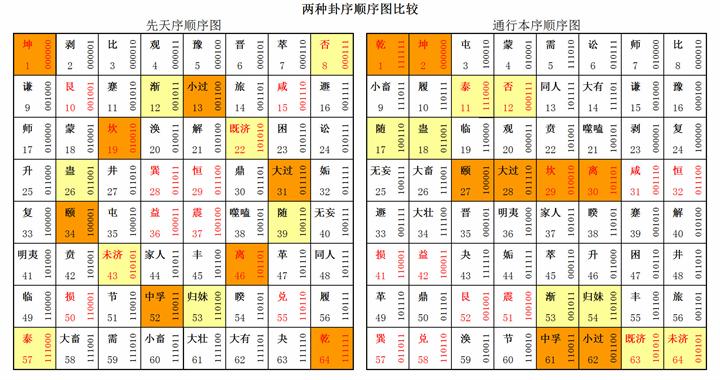
通行本序方图:
Left-hand figure: Square Fuxi 64-hexagram sequence;
Right-hand figure: King Wen hexagram sequence, the 64 hexagrams
can be grouped into 32 pairs (三十二個卦體).
For 28 of the pairs (white or colored in yellow),
the second hexagram is obtained by turning the first upside down (綜卦).
However, 8 symmetrical hexagrams (乾/1, 坤/2, 頤/27, 大過/28, 習坎/29, 離/30,
中孚/61, and 小過/62 colored in orange) are the same after 180° rotation (自綜卦).
In each pair of (orange or yellow) colored hexagrams, lines are inverted,
yin lines become yang lines and yang lines become yin lines (一對相錯卦).
《周易》上经以纯卦为主,首先以乾、坤二纯卦统八卦,其次以泰、否二交卦统十六卦, 最后以坎、离二纯卦为上经之终;下经以交卦为主,首先以咸、恒二交卦统八卦, 其次以损、益二交卦统八卦,然后以震、艮二纯卦统四卦,以巽、兑二纯卦统四卦, 最后以既济、未济二交卦为下经之终 (red characters)。
* 郭顺红
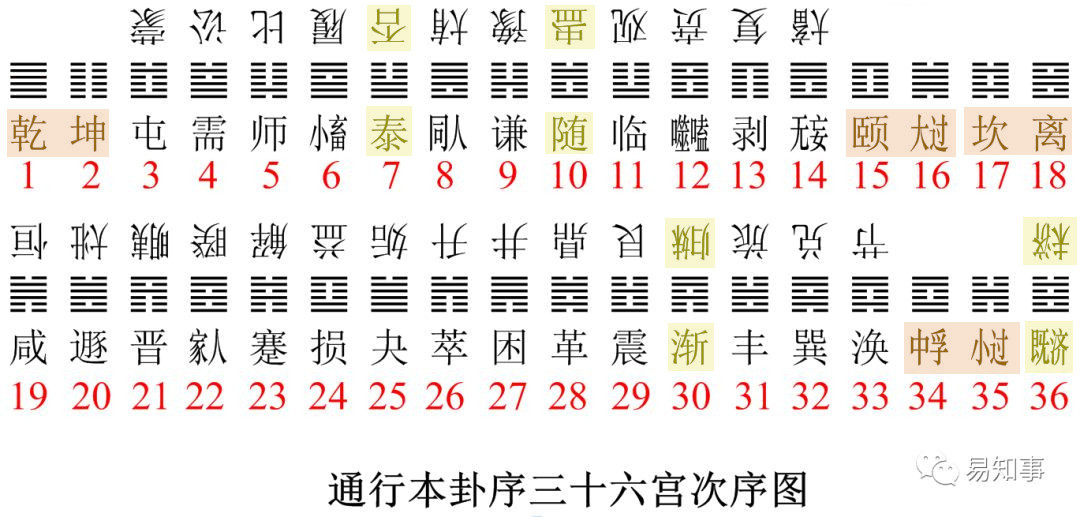
周易掛序新解
* 360doc,
纠正对“覆卦”“错卦”的错误认识:
综卦 = 反卦 = 覆卦
* 每日頭條,
《易經》- 易經體例、卦中有卦:
綜卦: 把本卦旋轉180度所得到的卦
錯卦: 把本卦的每一爻性質變為相反(陰變陽,陽變陰)
交卦: 把本卦上下卦互相交換。

* 每日頭條,
本卦、互卦、變卦、錯卦、綜卦及作用:
互卦是由本卦的兩個內卦組合而成的。具體組合方法是:本卦中的第三、四、五爻,
拿出來作為互卦的上卦,本卦的第二、三、四爻,拿出來作為互卦的下卦。
上卦、下卦組合在一起,就得到了互卦。
互卦是代表中间过程。
* Pixnet
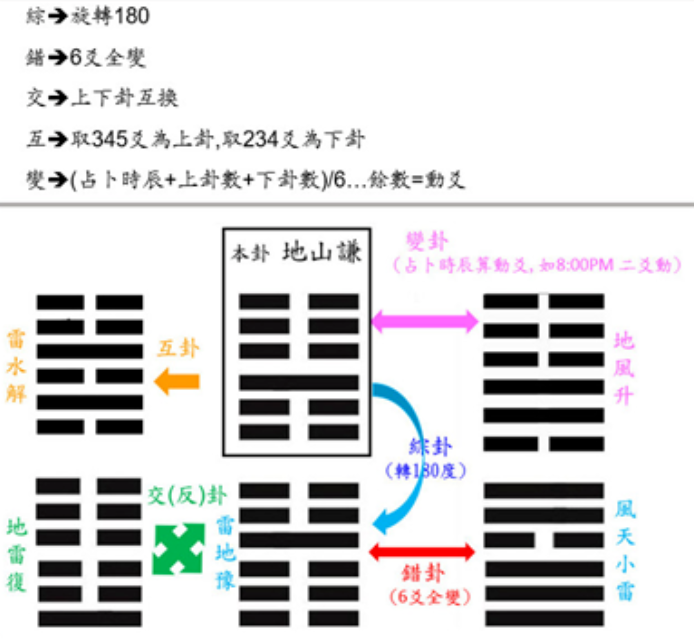
易經的正卦、綜卦、錯卦、交卦、互卦、變卦
* Bilibili:
史上最接地气《易经》六十四卦讲解!
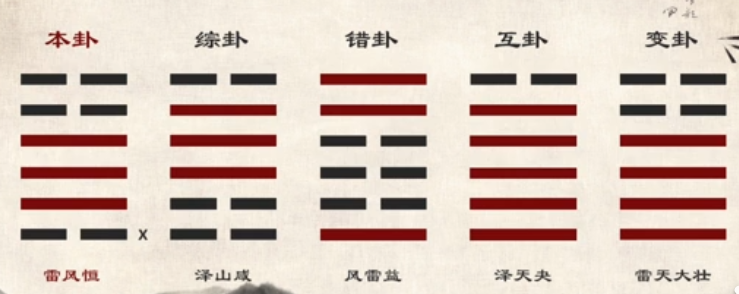
* 360doc, 陳證升,
64卦--綜卦--錯卦--互卦對照表:
互卦 234爻下卦 345爻上卦
* 易學網
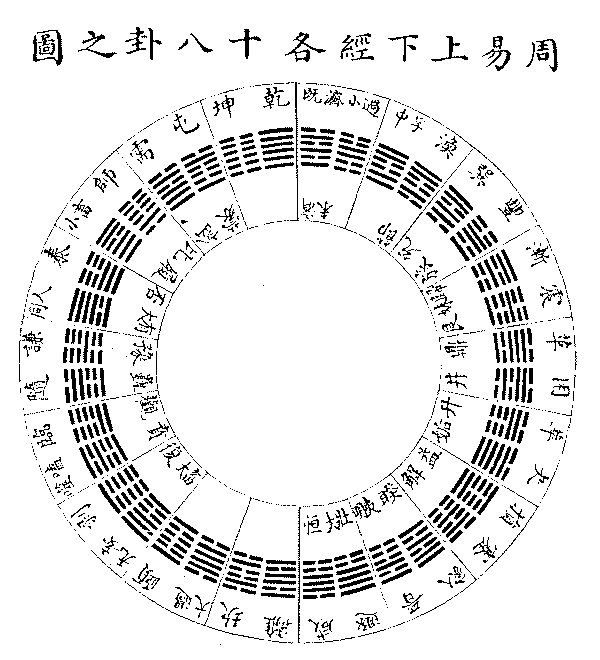
易分上下二篇
* 搜狐 sohu.com
轻松学《易经》:
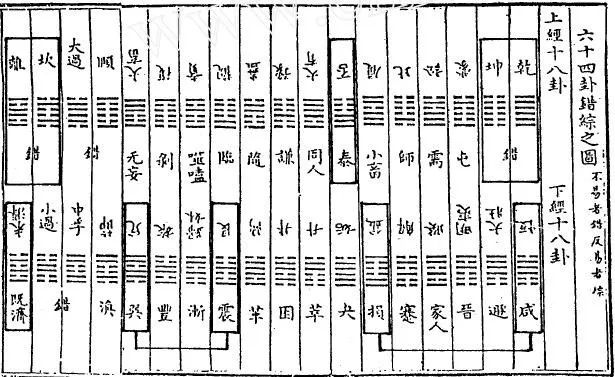
周易六十四卦按“非覆即变”原则分为上下十八宫,
上经十八宫30卦,以乾坤、泰否、坎离为枢纽(主卦),
下经十八宫34卦以咸恒、损益、既济未济为枢纽,杂以震艮、巽兑。
上经乾坤距离泰否四个宫位,泰否距离坎离九个宫位。
下经咸恒距离损益四个宫位,损益距离既济未济也是九个宫位
(不包括震艮巽兑四卦)。
* 易學網
易經64卦卦序顯示工具:

利用這個工具,可以清楚看到八卦在64卦中的位置與變化。
上经三十卦,大多由乾、坤、坎、离这四个基本卦所组成,而下经三十四卦,大多由艮、 震、兑、巽所组成。在先天八卦图中,乾、坤、坎、离四个卦,处在四个正位; 而艮、震、兑、巽处在四个斜角。
* 搜狐,
轻松学《易经》:破译《序卦传》的象数规律 :
周易卦序的节点应该有乾、坤、艮、兑、震、巽、坎、离八经卦组成的八重卦(八纯卦),
和天地否卦、地天泰卦、山泽损、泽山咸、
雷风恒、风雷益、水火既济、火水未济(八交卦)。
按“非覆即变”原则,乾坤为一对,泰否为一对,坎离为一对,既济未济为一对,咸恒为一对,
损益为一对,震艮为一对,巽兑为一对,一共16个主卦。
《周易》上经以纯卦为主,首先以乾、坤二纯卦统八卦,其次以泰、否二交卦统十六卦, 最后以坎、离二纯卦为上经之终;下经以交卦为主,首先以咸、恒二交卦统八卦, 其次以损、益二交卦统八卦,然后以震、艮二纯卦统四卦,以巽、兑二纯卦统四卦, 最后以既济、未济二交卦为下经之终。
* 搜狐,
易经中的“非覆即变”是什么意思:
错卦 = 变卦; 综卦 = 覆卦
易经64卦排列的规律是非覆即变,说的就是易经64卦,可以看做是32组,
两两一组的往下排,这两个卦要么是覆卦,也就是颠倒过来的,要么是变卦,就是每一爻发生变化的。
这个规律对人们学习易经是很有启发的,告诉大家在平时遇见问题的时候,不仅要正着想一想,
还要反着推理一下,有时候还需要完全站在另外一个角度看这个问题,这样就更加深入的了解这个问题,
从而找到解决问题的办法。

* 腾讯, 易经中的“非覆即变”是什么意思,易经基础知识
* Four Pillars & Feng Shui, D. H. Van den Berghe
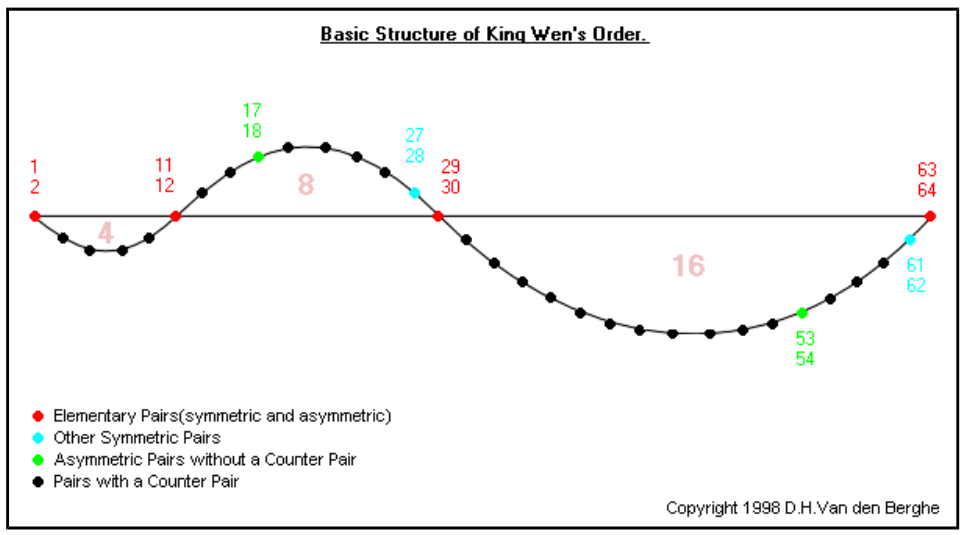
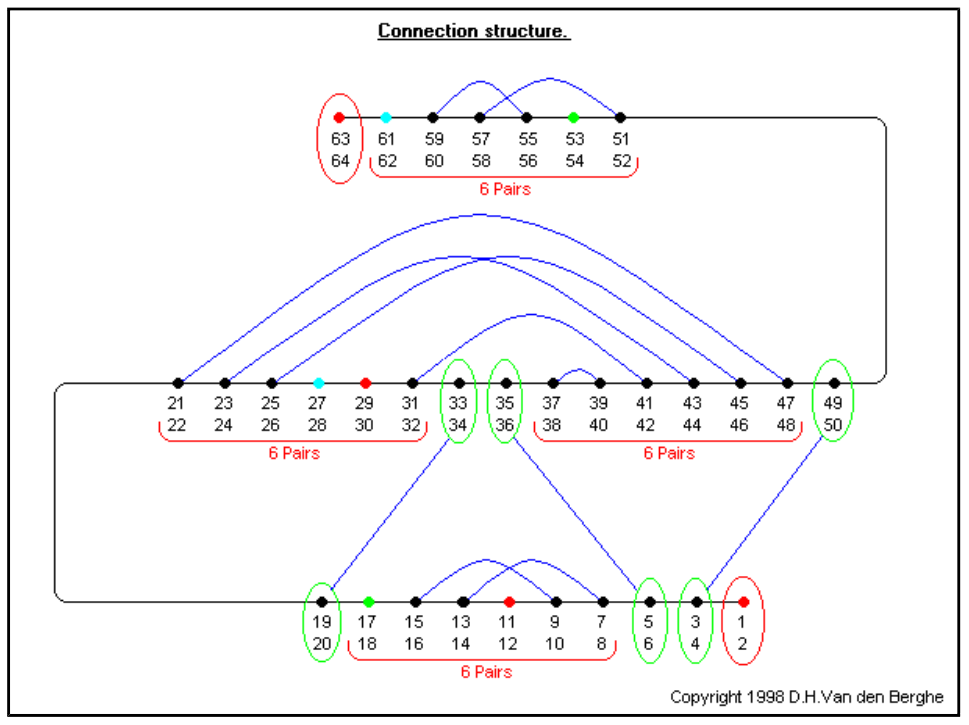
The explanation of King Wen’s order of the 64 hexagrams (PDF):
The hexagrams are arranged in 32 pairs.
Most hexagrams are coupled with their inverse hexagram
(the inverse hexagram is obtained by turning it upside down).
Eight hexagrams (乾/1, 坤/2, 頤/27, 大過/28, 習坎/29, 離/30, 中孚/61, and 小過/62)
don't change by turning them upside down
because they are symmetric. These hexagrams are coupled with their counter hexagram
(the counter hexagram is found by changing all the lines).
This means that most pairs have a counter pair.
The pairs 1/2 (乾/坤), 11/12 (泰/否), 29/30 (習坎/離), 63/64 (既濟/未濟) stand out in this group because
they are simple combinations of the Heaven/Earth and Water/Fire trigrams respectively.
I call them elementary pairs.
The two asymmetric pairs without a counter pair (17/18 [隨/蠱] and 53/54 [漸/歸妹])
are found in interesting spots too: the first pair is six spots
before and the second one is twelve spots after the elementary pair 29/30 (習坎/離)
(again a doubling of the distance).
* KingWen, József Drasny
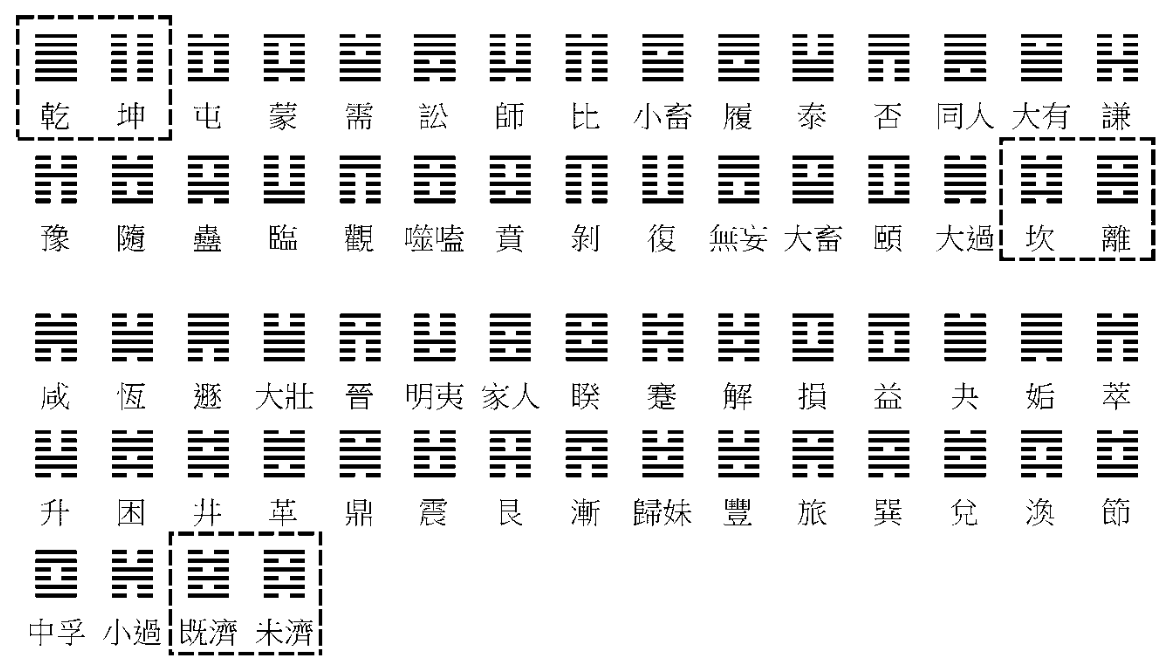
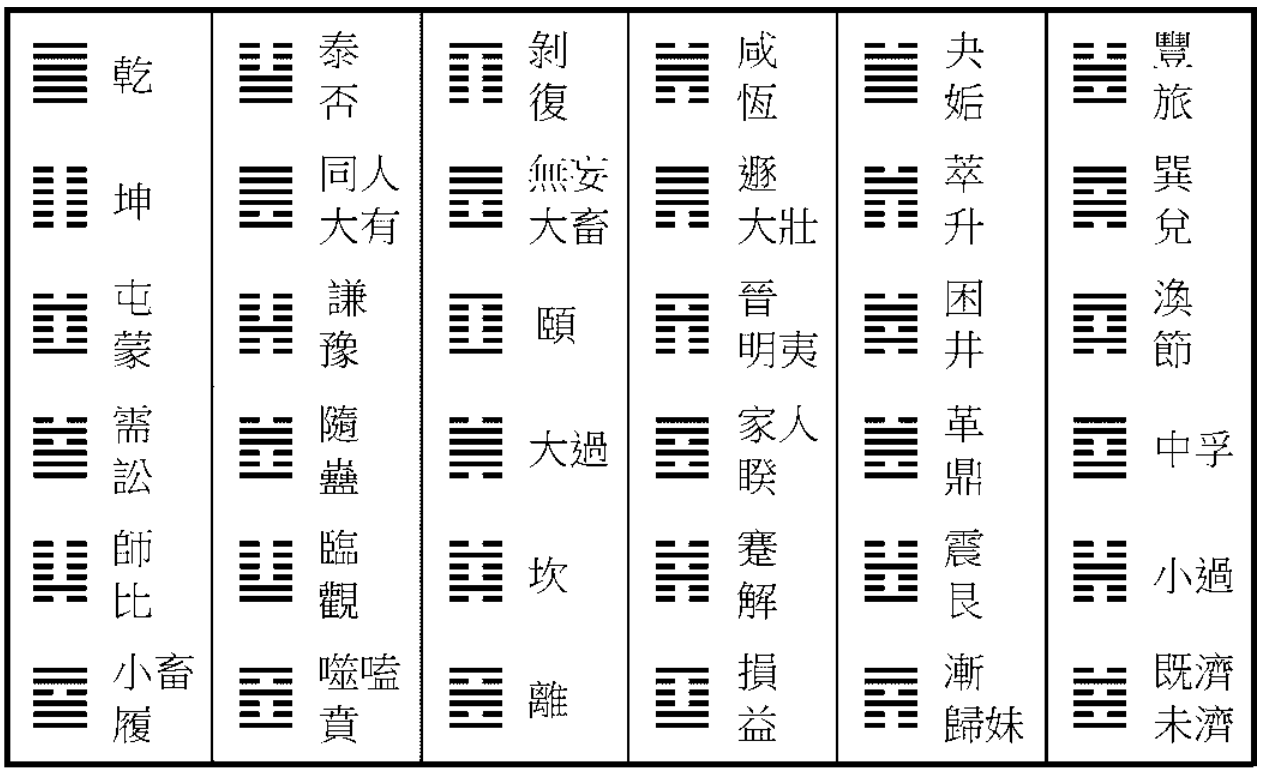
The regular grouping of the Hexagrams before the Yi jing-The King Wen groups
(PDF):
In this sequence, there are two frequently noted regularities:
Each odd-numbered hexagram, except the eight symmetrical ones,
is followed by its inverse opposite (twenty-eight pairs altogether),
and the eight symmetrical hexagrams are in pairs with their complementary
opposites (four pairs). Moreover, the hexagrams are traditionally divided
into two sections: There are thirty hexagrams in the first section
and thirty-four in the second section.
In the figure, there are three hexagram pairs framed by broken lines:
One pair is at the beginning and another at the end of the first section,
and the third is at the end of the second section.
* Biroco, József Drasny
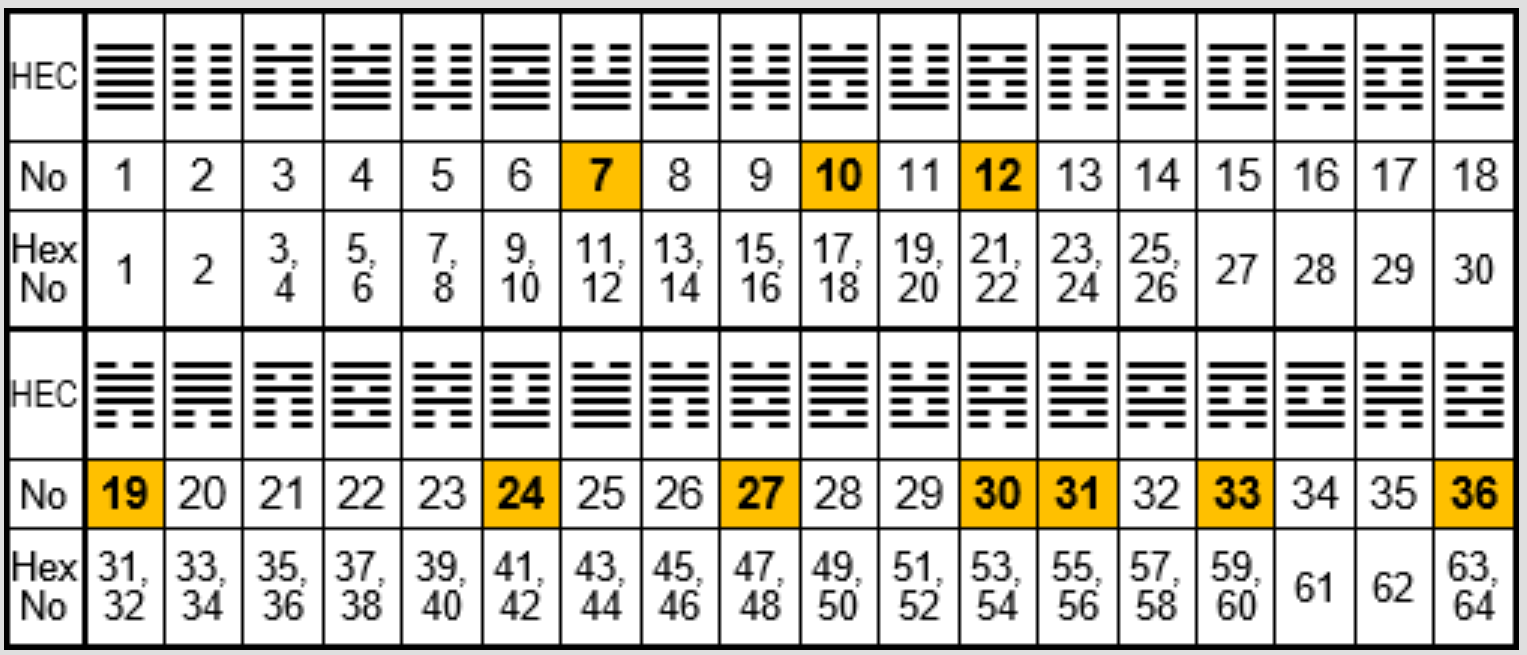
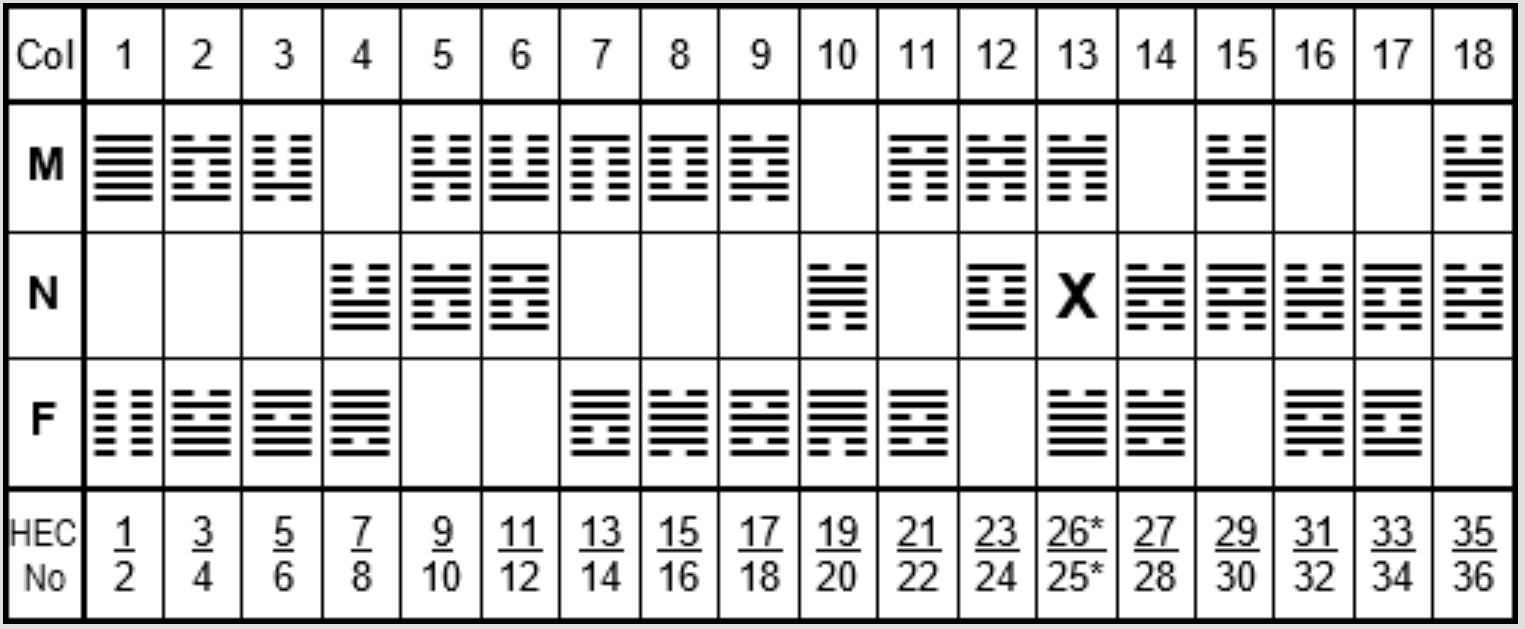
Richard S Cook’s classical Chinese combinatorics – a review article:
In this system of representation, the two hexagrams of the invertible pairs
are equivalent and form an equivalency class. These classes are represented
by one of their hexagrams (usually by the first one in the left-to-right
reading of the sequence). The symmetrical (non-invertible) hexagrams remain separate,
and each of them is a class in itself. The King Wen sequence contains 56 invertible hexagrams
(28 invertible pairs), and eight symmetrical hexagrams (eight non-invertible hexagrams).
Thus, there are 28+8=36 hexagram equivalency classes (HEC) altogether.
The elements highlighted in orange have three yang and yin lines (Level III of Yi-globe).
Each hexagram equivalency classe in the columns went in the cell that corresponded to its gender:
M (male), N (neuter), or F (female). The male and female genders are
like those in the case of the trigrams where the sons have a single yang line,
and the daughters have a single yin. In the hexagrams, the minority of
yang lines means males, and the females have a minority of yin lines.
* LiSe,
The Gritter grid: the hidden pattern in the classical sequence of the I Ching
(PDF)
The eight symmetrical hexagrams, which do not have reversed pairs, are
on the symmetry plane of Yi-globe (the plane of the screen):

上经有六个卦是没有综卦。下经有二个卦是没有综卦。
The eight hexagrams composed of two identical trigrams (double trigrams)
are on the vertical axis of Yi-globe
and on the main diagonal of square Fuxi 64-hexagram sequence:

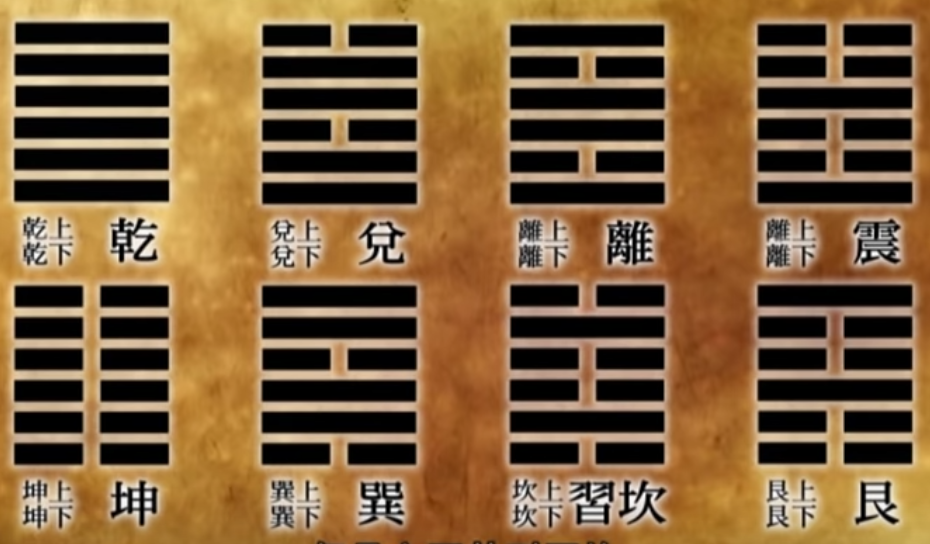
The eight hexagrams composed of two opposing trigrams in Fuxi trigrams
are on the level III of Yi-globe and
on the second diagonal of square Fuxi 64-hexagram sequence:

* 華文頭條
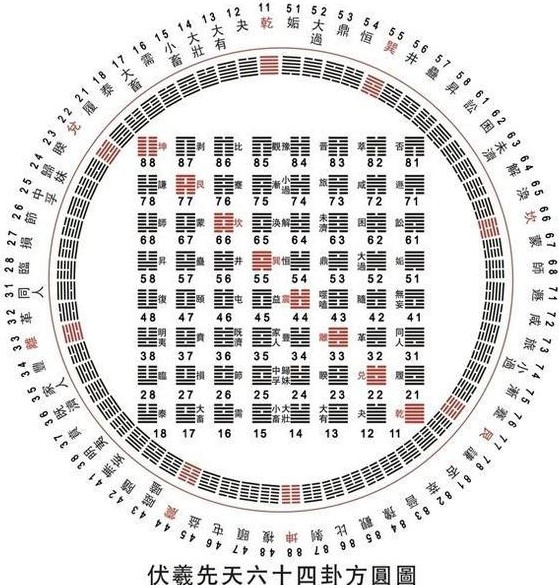
《易經》:學《易》繞不開的圖——《伏羲先天六十四卦方圓圖》:
相交卦,相錯卦在方圖中
* Udn
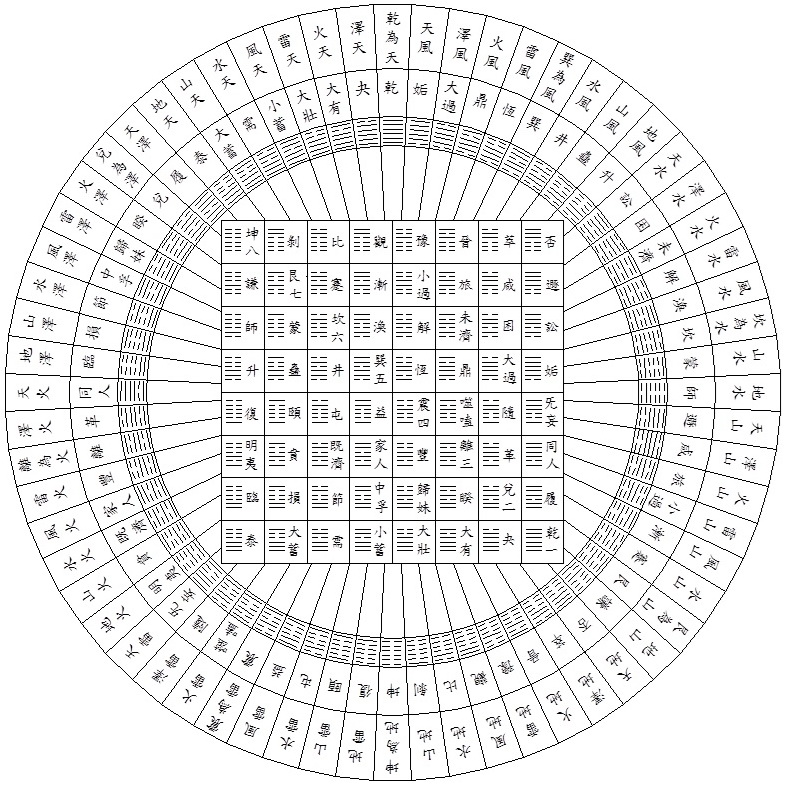
易經 :六十四卦方圓圖:
相交卦,相錯卦在方圖中
* Hexagrammatics, Larry J. Schulz

Structural principles in the Zhou Yijing 周易經 hexagram sequence,
Journal of Chinese Philosophy 38:4 (December 2011) 639–665:
The Ming Dynasty scholar Lai Zhide 來知德 (1525-1604 A.D.) made several observations.
One was the significant placement of the 8 Right (zheng 正) Hexagrams,
which have no Inverts (they are the same whether read top to bottom or bottom to top),
at the beginning and end of the Upper Classic and end of the Lower. These Right
Hexagrams are Stations 1, 2, 15, 16, 17, 18, 34, and 35.
S1/乾 is the Trigram Qian doubled, S2/坤 is Kun doubled, S17/習坎 is Double Kan, and S18/離 is Double Li.
S15/頤 and S34/中孚 have the image of Li, solid on the outsides and open in the middle.
S16/大過 and S35/小過 have the image of Kan.
S36, which is not a Right Hexagram Station, is the Trigram Kan atop the Trigram Li.
Thus, both the Upper and Lower Classic end with repeated references to Kan and Li.
Lai Zhide was also interested in the first 12 Hexagrams of the Upper Classic and the Lower Classic. He suggested that these placements were parallel, intended to highlight the Hexagrams 11/泰, 12/否, 41/損, and 42/益. These, he believed were pivotal to the meaning of the Upper and Lower Classic division.
The first 10 hexagrams in each of these sets has 30 solid and 30 bipartite lines. To Lai Zhide, this equal count repeated at the beginning of the Upper and Lower Classic represented the balance of Yang and Yin, and proved, as the Xugua Commentary implied, that the Zhou Yijing‘s visual structure was an imitation of nature. The Hexagram pairs 11/泰 and 12/否 and H41/損 and H42/益 were the "Masters, zhu 主" of their respective Classics, and the Hexagrams that followed them in each case issued from them.
H11/泰 and H12/否 are the only hexagrams composed of the Trigrams Qian and Kun
as their top and bottom three lines. They are thereby linked to H1/乾, which is the
doubled Qian Trigram, and H2/坤, doubled Kun.
H41/損 and 42/益 are composed of the four non-Right
or Invertible Trigrams, which Lai Zhide saw as dominating the meaning of the Lower Classic.
H41/損 is Gen atop Dui, H42/益 is Xun atop Chen. Lai Zhide noted that H41/損 and H42/益 are Opposite in linear composition to the first two hexagrams in the Lower Classic, H31/咸 and H32/恆. These four Hexagrams are the four possible combinations of the non-Right Trigrams. Thus, to Lai Zhide the two Classics begin in parallel arrays that highlight six of the eight hexagrams built uniquely from the Right Trigrams in the Upper Classic and in the Lower Classic from the non-Right Trigrams. The other hexagram similarly constituted is S36 at the end of the Sequence, composed of the Trigrams Kan and Li.
* Hexagrammatics, Larry J. Schulz
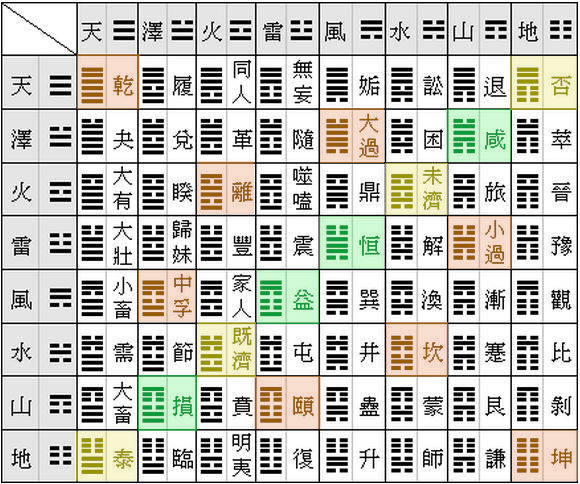
Hexagrammatics: Rules and properties in Binary Sequences
5. Yi-globe
* I-Ching, József Drasny
相交卦: 需,訟 (5/6); 師,比 (7/8); 泰,否 (11/12); 同人,大有 (13/14);
晉,明夷 (35/36); 既濟,未濟 (63/64).


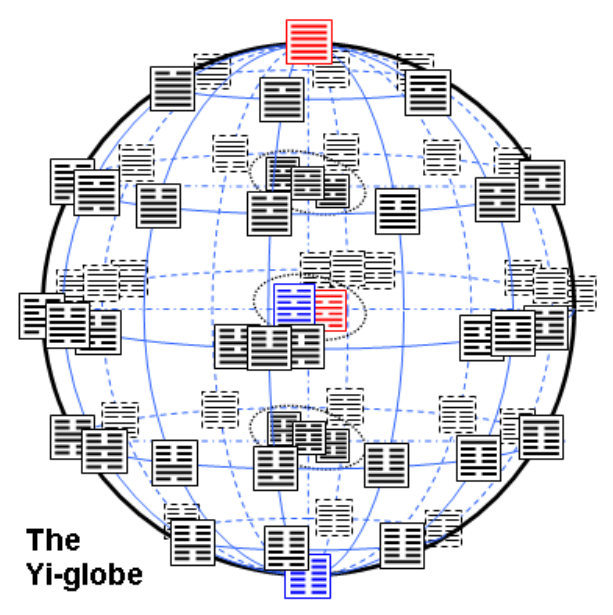
A study on the traditional (King Wen's) sequence of the sixty-four hexagrams
(PDF):
There are twelve meridians on the globe.
There are fifty-four hexagrams over the globe‘s surface,
at the points of intersection of the parallels and the meridians.
There are eight hexagrams on the axis of the globe, between the Creative/乾 and the Receptive/坤 [level II: three double trigrams (No 29/习坎, 51/震, 52/艮); level IV: the other three double trigrams (No 30/離, 57/巽, 58/兌); level III: After Completion and Before Completion (No 63/既濟 and 64/未濟)].
♥ A hexagram and its reverse pair (相綜卦) are always on the same level, and are settled symmetrically on the two sides of the globe. The plane of symmetry coincides with the plane of the screen. This plane contains the eight double trigrams (No 1/乾-2/坤, 29/习坎-30/離, 51/震-52/艮, 57/巽-58/兌), the two hexagrams of Completion (No 63/既濟-64/未濟), and the eight symmetrical hexagrams (No 1/乾-2/坤, 27/頤-28/大過, 29/习坎-30/離, 61/中孚-62/小過).
The eight symmetrical hexagrams, which do not have reversed pairs, are on the plane of symmetry (No 1/乾, 2/坤, 27/頤, 28/大過, 61/中孚, 62/小過, 29/习坎, and 30/離).
♥ The complementary pairs (相錯卦) are settled symmetrically with respect to the center of the globe.
The two complementary pairs on the axis are inside the globe but also symmetrical to the center.
* 易學網, 六十四卦相生圖
* Wikipedia,
Période solaire:
Les périodes solaires ou « saisons » correspondent, dans les calendrier chinois,
à vingt-quatre divisions de 15° de la course du soleil le long de l'écliptique.
Chaque période dure environ quinze jours.
* 香港天文台, 二十四節氣的日期及時間資料
* Biroco, Mark Shackelford The T’ai Chi and the cycle of Chinese months
* 嘻嘻网
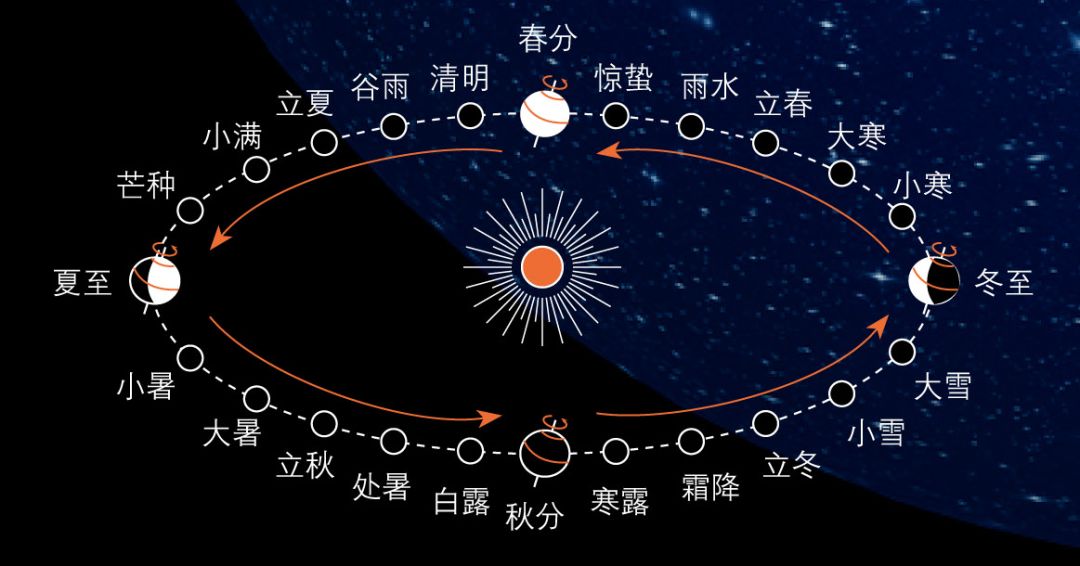
二十四节气
| 立春 | 4 février | Établissement du printemps |
| 春分 | 21 mars | Équinoxe de printemps |
| 立夏 | 6 mai | Établissement de l'été |
| 夏至 | 21 juin | Solstice d'été |
| 立秋 | 7 août | Établissement de l'automne |
| 秋分 | 23 septembre | Équinoxe d'automne |
| 立冬 | 7 novembre | Établissement de l'hiver |
| 冬至 | 22 décembre | Solstice d'hiver |
* YouTube, 觀天之道
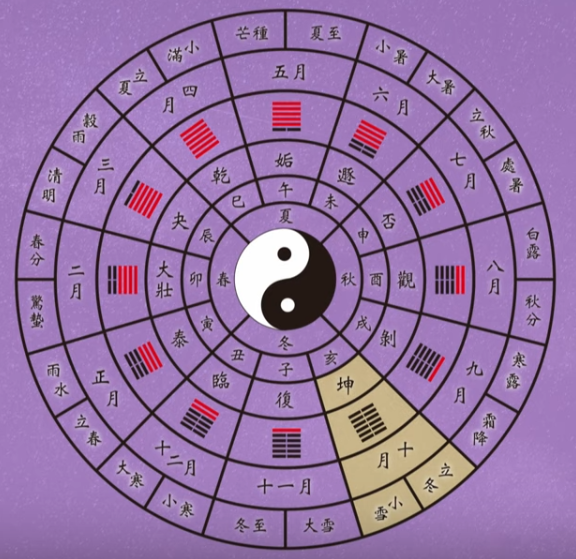
中國曆法與易經
* YouTube, 觀天之道 你真的讀懂通勝嗎?
* I-Ching, József Drasny


A study on the traditional (King Wen's) sequence of the sixty-four hexagrams
(PDF):
The twelve meridians of the Yi-globe correspond to the twelve months of the year.
正月為泰, 七月為否.
* I-Ching, József Drasny
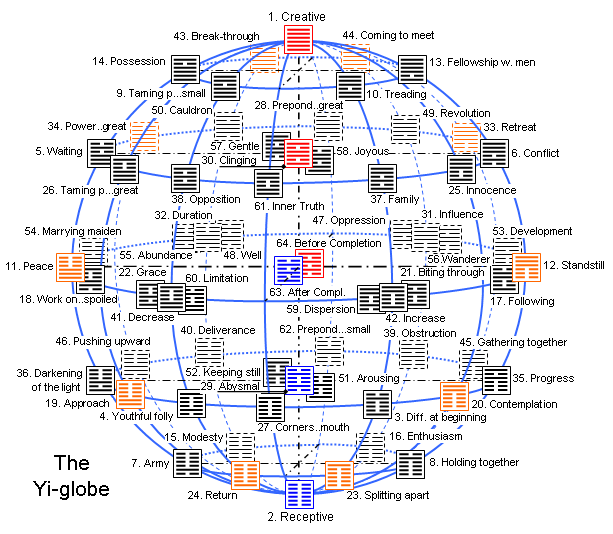
The Yi-globe: The Image of the Cosmos in the Yijing
(PDF):
The hexagrams in King Wen sequence are divided into two groups (No 1-30 and 31-64).
The two groups of the hexagrams are not shown separately in the Yi-globe.
The sexagenary cycle:
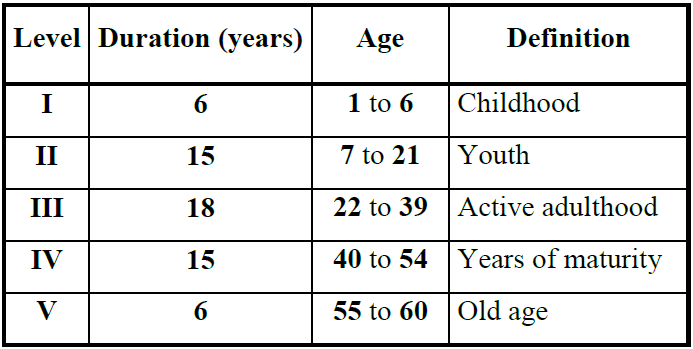
Certain hexagrams refer specifically to the features
of the age, and these hexagrams are positioned exactly on the level corresponding
to the given age. Consider the following examples:
Level I (childhood): Return (復, 24) and Splitting Apart (剝, 23) can be associated with birth.
Level II (youth): Difficulty at the Beginning (屯, 3) and Youthful Folly (蒙, 4) refer to age;
Progress (晉, 35), Pushing Upward (升, 46), and Approach (臨, 19) are the activities of the young.
Level III (young adulthood): The Marrying Maiden (歸妹, 54), Influence or Wooing (咸, 31) ,
Duration (恆, 32), and Development (漸, 53) are connected with marriage. This level contains
the branching points of life towards Abundance (豐, 55) or Oppression (困, 47), Increase (益, 42)
or Decrease (損, 41), Limitation (節, 60) or Dispersion (渙, 59).
Level IV (years of maturity): Inner Truth (中孚, 61) and The Family (家人, 37) present
the results of inner development. The greatness corresponds to the
attained spiritual level: The Power of the Great (大壯, 34), Preponderance of the Great (大過, 28),
and The Taming Power of the Great (大畜, 26), while Retreat (遯, 33) marks the end of the age.
Level V (old age): Break-through (夬, 43) and Coming to Meet (姤, 44) perhaps already refer
to ascending into a higher region, to be followed by Return (復, 24) again on level I.
* YouTube, CCTV-4,《文明之旅》 20161210, 张其成
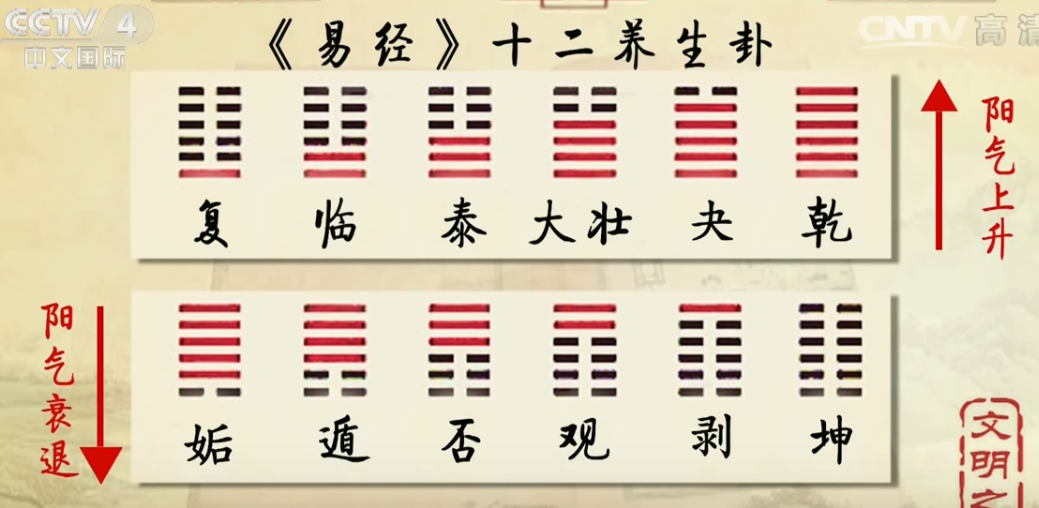
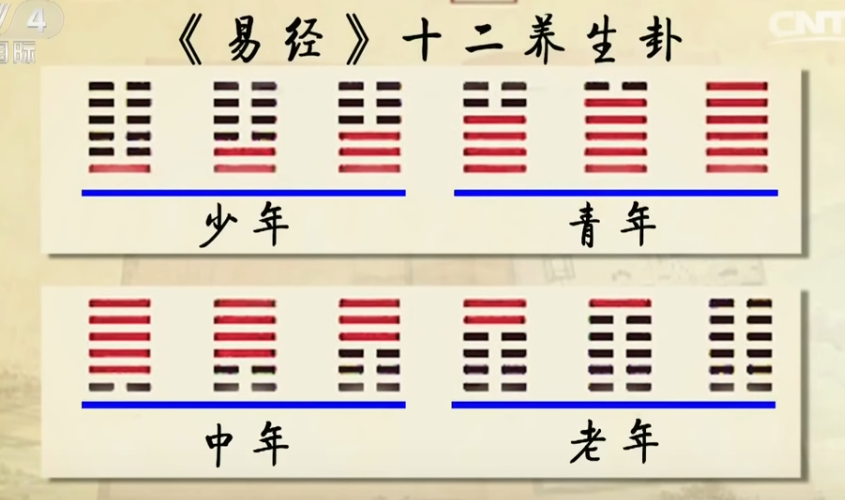
《易经》的养生智慧
* 360doc

《易经》原文全解析——第31卦 咸:泽山咸卦
6. The Managing Wisdom of I Ching 曾仕强—易经中的管理智慧 (YouTube)
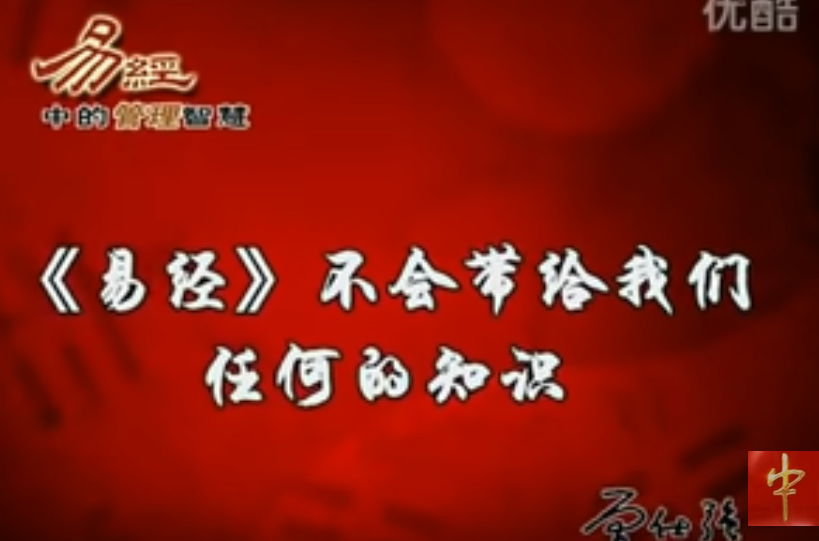
* 第一部(一) 道法自然
baike.baidu.com 道法自然
人图书馆 360doc.com, Askaluo 道法自然(2), 道法自然(3), 道法自然(4), 道法自然(5)---曾仕强
* 第一部(二) 天地人和
人图书馆 360doc.com, Askaluo 天地人和(1), 天地人和(2), 天地人和(3), 天地人和(4), 天地人和(5), 天地人和(6)---曾仕强
* 第一部(三) 阴阳之道
人图书馆 360doc.com, Askaluo 阴阳之道(1), 阴阳之道(2), 阴阳之道(3), 阴阳之道(4), 阴阳之道(5)---曾仕强
* 第一部(四) 明位立德
人图书馆 360doc.com, Askaluo 明位立德(2), 明位立德(3), 明位立德(4), 明位立德(5)---曾仕强
* 第二部(一) 树状组织
人图书馆 360doc.com, Askaluo 树状组织(2), 树状组织(3), 树状组织(4)---曾仕强
* 第二部(二) 用九用六
人图书馆 360doc.com, Askaluo 用九用六(1), 用九用六(2), 用九用六(3)---曾仕强
* 第二部(三) 合作分工
* 第二部(四) 关心为上
* 第三部(一) 易之大道
* 第三部(二) 乐天知命
* 第三部(三) 易道思维
* 第三部(四) 善尽责任
* YouKu, 曾仕强 《人性管理》
* YouTube, 曾仕强 《人性管理》
* 新浪, 曾仕强 《人性管理》


